Essay Papers Writing Online
Ultimate guide to writing a five paragraph essay.
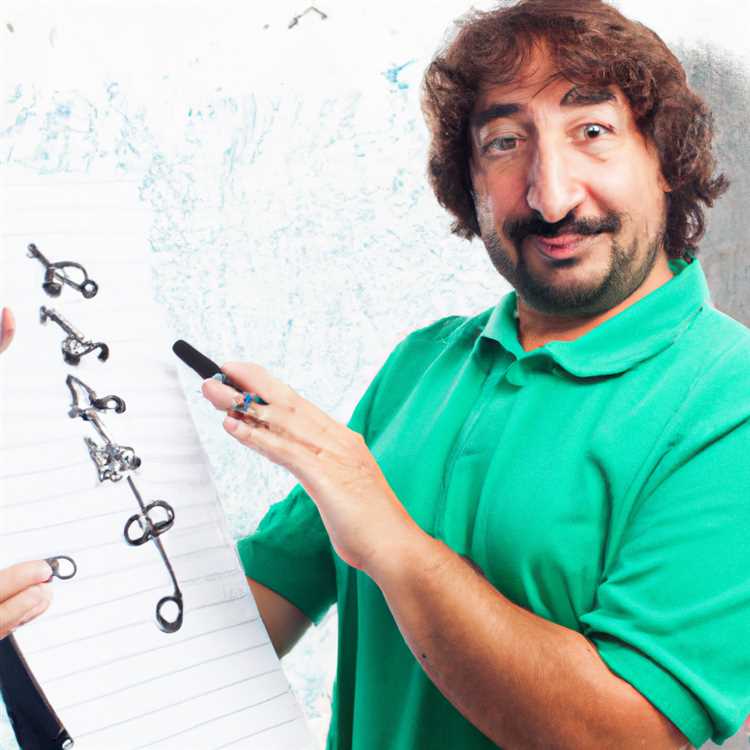
Are you struggling with writing essays? Do you find yourself lost in a sea of ideas, unable to structure your thoughts cohesively? The five paragraph essay is a tried-and-true method that can guide you through the writing process with ease. By mastering this format, you can unlock the key to successful and organized writing.
In this article, we will break down the five paragraph essay into easy steps that anyone can follow. From crafting a strong thesis statement to effectively supporting your arguments, we will cover all the essential components of a well-written essay. Whether you are a beginner or a seasoned writer, these tips will help you hone your skills and express your ideas clearly.

Step-by-Step Guide to Mastering the Five Paragraph Essay
Writing a successful five paragraph essay can seem like a daunting task, but with the right approach and strategies, it can become much more manageable. Follow these steps to master the art of writing a powerful five paragraph essay:
- Understand the structure: The five paragraph essay consists of an introduction, three body paragraphs, and a conclusion. Each paragraph serves a specific purpose in conveying your message effectively.
- Brainstorm and plan: Before you start writing, take the time to brainstorm ideas and create an outline. This will help you organize your thoughts and ensure that your essay flows smoothly.
- Write the introduction: Start your essay with a strong hook to grab the reader’s attention. Your introduction should also include a thesis statement, which is the main argument of your essay.
- Develop the body paragraphs: Each body paragraph should focus on a single point that supports your thesis. Use evidence, examples, and analysis to strengthen your argument and make your points clear.
- Conclude effectively: In your conclusion, summarize your main points and restate your thesis in a new way. Leave the reader with a thought-provoking statement or a call to action.
By following these steps and practicing regularly, you can become proficient in writing five paragraph essays that are clear, coherent, and impactful. Remember to revise and edit your work for grammar, punctuation, and clarity to ensure that your essay is polished and professional.
Understanding the Structure of a Five Paragraph Essay

When writing a five paragraph essay, it is important to understand the basic structure that makes up this type of essay. The five paragraph essay consists of an introduction, three body paragraphs, and a conclusion.
Introduction: The introduction is the first paragraph of the essay and sets the tone for the rest of the piece. It should include a hook to grab the reader’s attention, a thesis statement that presents the main idea of the essay, and a brief overview of what will be discussed in the body paragraphs.
Body Paragraphs: The body paragraphs make up the core of the essay and each paragraph should focus on a single point that supports the thesis statement. These paragraphs should include a topic sentence that introduces the main idea, supporting details or evidence, and explanations or analysis of how the evidence supports the thesis.
Conclusion: The conclusion is the final paragraph of the essay and it should summarize the main points discussed in the body paragraphs. It should restate the thesis in different words, and provide a closing thought or reflection on the topic.
By understanding the structure of a five paragraph essay, writers can effectively organize their thoughts and present their ideas in a clear and coherent manner.
Choosing a Strong Thesis Statement
One of the most critical elements of a successful five-paragraph essay is a strong thesis statement. Your thesis statement should clearly and concisely present the main argument or point you will be making in your essay. It serves as the foundation for the entire essay, guiding the reader on what to expect and helping you stay focused throughout your writing.
When choosing a thesis statement, it’s important to make sure it is specific, debatable, and relevant to your topic. Avoid vague statements or generalizations, as they will weaken your argument and fail to provide a clear direction for your essay. Instead, choose a thesis statement that is narrow enough to be effectively supported within the confines of a five-paragraph essay, but broad enough to allow for meaningful discussion.
By choosing a strong thesis statement, you set yourself up for a successful essay that is well-organized, coherent, and persuasive. Take the time to carefully craft your thesis statement, as it will serve as the guiding force behind your entire essay.
Developing Supporting Arguments in Body Paragraphs
When crafting the body paragraphs of your five paragraph essay, it is crucial to develop strong and coherent supporting arguments that back up your thesis statement. Each body paragraph should focus on a single supporting argument that contributes to the overall discussion of your topic.
To effectively develop your supporting arguments, consider using a table to organize your ideas. Start by listing your main argument in the left column, and then provide evidence, examples, and analysis in the right column. This structured approach can help you ensure that each supporting argument is fully developed and logically presented.
Additionally, be sure to use transitional phrases to smoothly connect your supporting arguments within and between paragraphs. Words like “furthermore,” “in addition,” and “on the other hand” can help readers follow your train of thought and understand the progression of your ideas.
Remember, the body paragraphs are where you provide the meat of your argument, so take the time to develop each supporting argument thoroughly and clearly. By presenting compelling evidence and analysis, you can effectively persuade your readers and strengthen the overall impact of your essay.
Polishing Your Writing: Editing and Proofreading Tips
Editing and proofreading are crucial steps in the writing process that can make a significant difference in the clarity and effectiveness of your essay. Here are some tips to help you polish your writing:
1. Take a break before editing: After you finish writing your essay, take a break before starting the editing process. This will help you approach your work with fresh eyes and catch mistakes more easily.
2. Read your essay aloud: Reading your essay aloud can help you identify awkward phrasing, grammar errors, and inconsistencies. This technique can also help you evaluate the flow and coherence of your writing.
3. Use a spelling and grammar checker: Utilize spelling and grammar checkers available in word processing software to catch common errors. However, be mindful that these tools may not catch all mistakes, so it’s essential to manually review your essay as well.
4. Check for coherence and organization: Make sure your ideas flow logically and cohesively throughout your essay. Ensure that each paragraph connects smoothly to the next, and that your arguments are supported by relevant evidence.
5. Look for consistency: Check for consistency in your writing style, tone, and formatting. Ensure that you maintain a consistent voice and perspective throughout your essay to keep your argument coherent.
6. Seek feedback from others: Consider asking a peer, teacher, or tutor to review your essay and provide feedback. External perspectives can help you identify blind spots and areas for improvement in your writing.
7. Proofread carefully: Finally, proofread your essay carefully to catch any remaining errors in spelling, grammar, punctuation, and formatting. Pay attention to details and make any necessary revisions before submitting your final draft.
By following these editing and proofreading tips, you can refine your writing and ensure that your essay is polished and ready for submission.
Tips for Successful Writing: Practice and Feedback
Writing is a skill that improves with practice. The more you write, the better you will become. Set aside time each day to practice writing essays, paragraph by paragraph. This consistent practice will help you develop your writing skills and grow more confident in expressing your ideas.
Seek feedback from your teachers, peers, or mentors. Constructive criticism can help you identify areas for improvement and provide valuable insights into your writing. Take their suggestions into consideration and use them to refine your writing style and structure.
- Set writing goals for yourself and track your progress. Whether it’s completing a certain number of essays in a week or improving your introductions, having specific goals will keep you motivated and focused on your writing development.
- Read widely to expand your vocabulary and expose yourself to different writing styles. The more you read, the more you will learn about effective writing techniques and ways to engage your readers.
- Revise and edit your essays carefully. Pay attention to sentence structure, grammar, punctuation, and spelling. A well-polished essay will demonstrate your attention to detail and dedication to producing high-quality work.
Related Post
How to master the art of writing expository essays and captivate your audience, convenient and reliable source to purchase college essays online, step-by-step guide to crafting a powerful literary analysis essay, tips and techniques for crafting compelling narrative essays.
The Ultimate Guide to the 5-Paragraph Essay
PeopleImages / Getty Images
- M.Ed., Education Administration, University of Georgia
- B.A., History, Armstrong State University
A five-paragraph essay is a prose composition that follows a prescribed format of an introductory paragraph, three body paragraphs, and a concluding paragraph, and is typically taught during primary English education and applied on standardized testing throughout schooling.
Learning to write a high-quality five-paragraph essay is an essential skill for students in early English classes as it allows them to express certain ideas, claims, or concepts in an organized manner, complete with evidence that supports each of these notions. Later, though, students may decide to stray from the standard five-paragraph format and venture into writing an exploratory essay instead.
Still, teaching students to organize essays into the five-paragraph format is an easy way to introduce them to writing literary criticism, which will be tested time and again throughout their primary, secondary, and further education.
Writing a Good Introduction
The introduction is the first paragraph in your essay, and it should accomplish a few specific goals: capture the reader's interest, introduce the topic, and make a claim or express an opinion in a thesis statement.
It's a good idea to start your essay with a hook (fascinating statement) to pique the reader's interest, though this can also be accomplished by using descriptive words, an anecdote, an intriguing question, or an interesting fact. Students can practice with creative writing prompts to get some ideas for interesting ways to start an essay.
The next few sentences should explain your first statement, and prepare the reader for your thesis statement, which is typically the last sentence in the introduction. Your thesis sentence should provide your specific assertion and convey a clear point of view, which is typically divided into three distinct arguments that support this assertation, which will each serve as central themes for the body paragraphs.
Writing Body Paragraphs
The body of the essay will include three body paragraphs in a five-paragraph essay format, each limited to one main idea that supports your thesis.
To correctly write each of these three body paragraphs, you should state your supporting idea, your topic sentence, then back it up with two or three sentences of evidence. Use examples that validate the claim before concluding the paragraph and using transition words to lead to the paragraph that follows — meaning that all of your body paragraphs should follow the pattern of "statement, supporting ideas, transition statement."
Words to use as you transition from one paragraph to another include: moreover, in fact, on the whole, furthermore, as a result, simply put, for this reason, similarly, likewise, it follows that, naturally, by comparison, surely, and yet.
Writing a Conclusion
The final paragraph will summarize your main points and re-assert your main claim (from your thesis sentence). It should point out your main points, but should not repeat specific examples, and should, as always, leave a lasting impression on the reader.
The first sentence of the conclusion, therefore, should be used to restate the supporting claims argued in the body paragraphs as they relate to the thesis statement, then the next few sentences should be used to explain how the essay's main points can lead outward, perhaps to further thought on the topic. Ending the conclusion with a question, anecdote, or final pondering is a great way to leave a lasting impact.
Once you complete the first draft of your essay, it's a good idea to re-visit the thesis statement in your first paragraph. Read your essay to see if it flows well, and you might find that the supporting paragraphs are strong, but they don't address the exact focus of your thesis. Simply re-write your thesis sentence to fit your body and summary more exactly, and adjust the conclusion to wrap it all up nicely.
Practice Writing a Five-Paragraph Essay
Students can use the following steps to write a standard essay on any given topic. First, choose a topic, or ask your students to choose their topic, then allow them to form a basic five-paragraph by following these steps:
- Decide on your basic thesis , your idea of a topic to discuss.
- Decide on three pieces of supporting evidence you will use to prove your thesis.
- Write an introductory paragraph, including your thesis and evidence (in order of strength).
- Write your first body paragraph, starting with restating your thesis and focusing on your first piece of supporting evidence.
- End your first paragraph with a transitional sentence that leads to the next body paragraph.
- Write paragraph two of the body focussing on your second piece of evidence. Once again make the connection between your thesis and this piece of evidence.
- End your second paragraph with a transitional sentence that leads to paragraph number three.
- Repeat step 6 using your third piece of evidence.
- Begin your concluding paragraph by restating your thesis. Include the three points you've used to prove your thesis.
- End with a punch, a question, an anecdote, or an entertaining thought that will stay with the reader.
Once a student can master these 10 simple steps, writing a basic five-paragraph essay will be a piece of cake, so long as the student does so correctly and includes enough supporting information in each paragraph that all relate to the same centralized main idea, the thesis of the essay.
Limitations of the Five-Paragraph Essay
The five-paragraph essay is merely a starting point for students hoping to express their ideas in academic writing; there are some other forms and styles of writing that students should use to express their vocabulary in the written form.
According to Tory Young's "Studying English Literature: A Practical Guide":
"Although school students in the U.S. are examined on their ability to write a five-paragraph essay , its raison d'être is purportedly to give practice in basic writing skills that will lead to future success in more varied forms. Detractors feel, however, that writing to rule in this way is more likely to discourage imaginative writing and thinking than enable it. . . . The five-paragraph essay is less aware of its audience and sets out only to present information, an account or a kind of story rather than explicitly to persuade the reader."
Students should instead be asked to write other forms, such as journal entries, blog posts, reviews of goods or services, multi-paragraph research papers, and freeform expository writing around a central theme. Although five-paragraph essays are the golden rule when writing for standardized tests, experimentation with expression should be encouraged throughout primary schooling to bolster students' abilities to utilize the English language fully.
- How To Write an Essay
- How to Write a Great Essay for the TOEFL or TOEIC
- Write an Attention-Grabbing Opening Sentence for an Essay
- How to Write and Format an MBA Essay
- How to Structure an Essay
- How to Help Your 4th Grader Write a Biography
- Definition and Examples of Body Paragraphs in Composition
- What Is Expository Writing?
- What an Essay Is and How to Write One
- Paragraph Writing
- 3 Changes That Will Take Your Essay From Good To Great
- An Introduction to Academic Writing
- Tips on How to Write an Argumentative Essay
- The Five Steps of Writing an Essay
- How to Write a Solid Thesis Statement
- The Introductory Paragraph: Start Your Paper Off Right
Guide on How to Write a 5 Paragraph Essay Effortlessly

Defining What Is a 5 Paragraph Essay
Have you ever been assigned a five-paragraph essay and wondered what exactly it means? Don't worry; we all have been there. A five-paragraph essay is a standard academic writing format consisting of an introduction, three body paragraphs, and a conclusion.
In the introduction, you present your thesis statement, which is the main idea or argument you will discuss in your essay. The three body paragraphs present a separate supporting argument, while the conclusion summarizes the main points and restates the thesis differently.
While the five-paragraph essay is a tried and true format for many academic assignments, it's important to note that it's not the only way to write an essay. In fact, some educators argue that strict adherence to this format can stifle creativity and limit the development of more complex ideas.
However, mastering the five-paragraph essay is a valuable skill for any student, as it teaches the importance of structure and organization in writing. Also, it enables you to communicate your thoughts clearly and eloquently, which is crucial for effective communication in any area. So the next time you're faced with a five-paragraph essay assignment, embrace the challenge and use it as an opportunity to hone your writing skills.
And if you find it difficult to put your ideas into 5 paragraphs, ask our professional service - 'please write my essay ,' or ' write my paragraph ' and consider it done.
How to Write a 5 Paragraph Essay: General Tips
If you are struggling with how to write a 5 paragraph essay, don't worry! It's a common format that many students learn in their academic careers. Here are some tips from our admission essay writing service to help you write a successful five paragraph essay example:

- Start with a strong thesis statement : Among the 5 parts of essay, the thesis statement can be the most important. It presents the major topic you will debate throughout your essay while being explicit and simple.
- Use topic sentences to introduce each paragraph : The major idea you will address in each of the three body paragraphs should be established in a concise subject sentence.
- Use evidence to support your arguments : The evidence you present in your body paragraphs should back up your thesis. This can include facts, statistics, or examples from your research or personal experience.
- Include transitions: Use transitional words and phrases to make the flow of your essay easier. Words like 'although,' 'in addition,' and 'on the other hand' are examples of these.
- Write a strong conclusion: In addition to restating your thesis statement in a new way, your conclusion should highlight the key ideas of your essay. You might also leave the reader with a closing idea or query to reflect on.
- Edit and proofread: When you've completed writing your essay, thoroughly revise and proofread it. Make sure your thoughts are brief and clear and proofread your writing for grammatical and spelling mistakes.
By following these tips, you can write strong and effective five paragraph essays examples that will impress your teacher or professor.
5 Paragraph Essay Format
Let's readdress the five-paragraph essay format and explain it in more detail. So, as already mentioned, it is a widely-used writing structure taught in many schools and universities. A five-paragraph essay comprises an introduction, three body paragraphs, and a conclusion, each playing a significant role in creating a well-structured and coherent essay.
The introduction serves as the opening paragraph of the essay and sets the tone for the entire piece. It should captivate the reader's attention, provide relevant background information, and include a clear and concise thesis statement that presents the primary argument of the essay. For example, if the essay topic is about the benefits of exercise, the introduction may look something like this:
'Regular exercise provides numerous health benefits, including increased energy levels, improved mental health, and reduced risk of chronic diseases.'
The body paragraphs are the meat of the essay and should provide evidence and examples to support the thesis statement. Each body paragraph should begin with a subject sentence that states the major idea of the paragraph. Then, the writer should provide evidence to support the topic sentence. This evidence can be in the form of statistics, facts, or examples. For instance, if the essay is discussing the health benefits of exercise, a body paragraph might look like this:
'One of the key benefits of exercise is improved mental health. Regular exercise has been demonstrated in studies to lessen depressive and anxious symptoms and enhance mood.'
The essay's final paragraph, the conclusion, should repeat the thesis statement and summarize the essay's important ideas. A concluding idea or query might be included to give the reader something to ponder. For example, a conclusion for an essay on the benefits of exercise might look like this:
'In conclusion, exercise provides numerous health benefits, from increased energy levels to reduced risk of chronic diseases. We may enhance both our physical and emotional health and enjoy happier, more satisfying lives by including exercise into our daily routines.'
Overall, the 5 paragraph essay format is useful for organizing thoughts and ideas clearly and concisely. By following this format, writers can present their arguments logically and effectively, which is easy for the reader to follow.
Types of 5 Paragraph Essay
There are several types of five-paragraph essays, each with a slightly different focus or purpose. Here are some of the most common types of five-paragraph essays:

- Narrative essay : A narrative essay tells a story or recounts a personal experience. It typically includes a clear introductory paragraph, body sections that provide details about the story, and a conclusion that wraps up the narrative.
- Descriptive essay: A descriptive essay uses sensory language to describe a person, place, or thing. It often includes a clear thesis statement that identifies the subject of the description and body paragraphs that provide specific details to support the thesis.
- Expository essay: An expository essay offers details or clarifies a subject. It usually starts with a concise introduction that introduces the subject, is followed by body paragraphs that provide evidence and examples to back up the thesis, and ends with a summary of the key points.
- Persuasive essay: A persuasive essay argues for a particular viewpoint or position. It has a thesis statement that is clear, body paragraphs that give evidence and arguments in favor of it, and a conclusion that summarizes the important ideas and restates the thesis.
- Compare and contrast essay: An essay that compares and contrasts two or more subjects and looks at their similarities and differences. It usually starts out simply by introducing the topics being contrasted or compared, followed by body paragraphs that go into more depth on the similarities and differences, and a concluding paragraph that restates the important points.
Each type of five-paragraph essay has its own unique characteristics and requirements. When unsure how to write five paragraph essay, writers can choose the most appropriate structure for their topic by understanding the differences between these types.
5 Paragraph Essay Example Topics
Here are some potential topics for a 5 paragraph essay example. These essay topics are just a starting point and can be expanded upon to fit a wide range of writing essays and prompts.
- The Impact of Social Media on Teenage Communication Skills.
- How Daily Exercise Benefits Mental and Physical Health.
- The Importance of Learning a Second Language.
- The Effects of Global Warming on Marine Life.
- The Role of Technology in Modern Education.
- The Influence of Music on Youth Culture.
- The Pros and Cons of Uniform Policies in Schools.
- The Significance of Historical Monuments in Cultural Identity.
- The Growing Importance of Cybersecurity.
- The Evolution of the American Dream.
- The Impact of Diet on Cognitive Functioning.
- The Role of Art in Society.
- The Future of Renewable Energy Sources.
- The Effects of Urbanization on Wildlife.
- The Importance of Financial Literacy for Young Adults.
- The Influence of Advertising on Consumer Choices.
- The Role of Books in the Digital Age.\
- The Benefits and Challenges of Space Exploration.
- The Impact of Climate Change on Agriculture.
- The Ethical Implications of Genetic Modification.
Don't Let Essay Writing Stress You Out!
Order a high-quality, custom-written paper from our professional writing service and take the first step towards academic success!
General Grading Rubric for a 5 Paragraph Essay
The following is a general grading rubric that can be used to evaluate a five-paragraph essay:
Content (40%)
- A thesis statement is clear and specific
- The main points are well-developed and supported by evidence
- Ideas are organized logically and coherently
- Evidence and examples are relevant and support the main points
- The essay demonstrates a strong understanding of the topic
Organization (20%)
- The introduction effectively introduces the topic and thesis statement
- Body paragraphs are well-structured and have clear topic sentences
- Transitions between paragraphs are smooth and effective
- The concluding sentence effectively summarizes the main points and restates the thesis statement
Language and Style (20%)
- Writing is clear, concise, and easy to understand
- Language is appropriate for the audience and purpose
- Vocabulary is varied and appropriate
- Grammar, spelling, and punctuation are correct
Critical Thinking (20%)
- Student demonstrate an understanding of the topic beyond surface-level knowledge
- Student present a unique perspective or argument
- Student show evidence of critical thinking and analysis
- Students write well-supported conclusions
Considering the above, the paper should demonstrate a thorough understanding of the topic, clear organization, strong essay writing skills, and critical thinking. By using this grading rubric, the teacher can evaluate the essay holistically and provide detailed feedback to the student on areas of strength and areas for improvement.
Five Paragraph Essay Examples
Wrapping up: things to remember.
In conclusion, writing a five paragraph essay example can seem daunting at first, but it doesn't have to be a difficult task. Following these simple steps and tips, you can break down the process into manageable parts and create a clear, concise, and well-organized essay.
Remember to start with a strong thesis statement, use topic sentences to guide your paragraphs, and provide evidence and analysis to support your ideas. Don't forget to revise and proofread your work to make sure it is error-free and coherent. With time and practice, you'll be able to write a 5 paragraph essay with ease and assurance. Whether you're writing for school, work, or personal projects, these skills will serve you well and help you to communicate your ideas effectively.
Meanwhile, you can save time and reduce the stress associated with academic assignments by trusting our research paper writing services to handle the writing for you. So go ahead, buy an essay , and see how easy it can be to meet all of your professors' complex requirements!
Ready to Take the Stress Out of Essay Writing?
Order your 5 paragraph essay today and enjoy a high-quality, custom-written paper delivered promptly
Related Articles
%20(2).webp)
- PRO Courses Guides New Tech Help Pro Expert Videos About wikiHow Pro Upgrade Sign In
- EDIT Edit this Article
- EXPLORE Tech Help Pro About Us Random Article Quizzes Request a New Article Community Dashboard This Or That Game Popular Categories Arts and Entertainment Artwork Books Movies Computers and Electronics Computers Phone Skills Technology Hacks Health Men's Health Mental Health Women's Health Relationships Dating Love Relationship Issues Hobbies and Crafts Crafts Drawing Games Education & Communication Communication Skills Personal Development Studying Personal Care and Style Fashion Hair Care Personal Hygiene Youth Personal Care School Stuff Dating All Categories Arts and Entertainment Finance and Business Home and Garden Relationship Quizzes Cars & Other Vehicles Food and Entertaining Personal Care and Style Sports and Fitness Computers and Electronics Health Pets and Animals Travel Education & Communication Hobbies and Crafts Philosophy and Religion Work World Family Life Holidays and Traditions Relationships Youth
- Browse Articles
- Learn Something New
- Quizzes Hot
- This Or That Game New
- Train Your Brain
- Explore More
- Support wikiHow
- About wikiHow
- Log in / Sign up
- Education and Communications
- College University and Postgraduate
- Academic Writing
How to Write a Five Paragraph Essay
Last Updated: April 4, 2024 Fact Checked
This article was co-authored by Jake Adams and by wikiHow staff writer, Danielle Blinka, MA, MPA . Jake Adams is an academic tutor and the owner of Simplifi EDU, a Santa Monica, California based online tutoring business offering learning resources and online tutors for academic subjects K-College, SAT & ACT prep, and college admissions applications. With over 14 years of professional tutoring experience, Jake is dedicated to providing his clients the very best online tutoring experience and access to a network of excellent undergraduate and graduate-level tutors from top colleges all over the nation. Jake holds a BS in International Business and Marketing from Pepperdine University. There are 8 references cited in this article, which can be found at the bottom of the page. This article has been fact-checked, ensuring the accuracy of any cited facts and confirming the authority of its sources. This article has been viewed 523,759 times.
Five paragraph essays are a common assignment throughout your school career, especially in high school and college. Since any subject can include a five paragraph essay, you’ll want to be good at writing them. Luckily, five-paragraph essays are really easy to write if you know the expected format and give yourself the time you need to write it. To write your five paragraph essay, draft your introduction, develop three body paragraphs, write your conclusion, and revise and edit your essay.
Drafting Your Introduction

- For example, you could phrase your hook like this: Nature’s life cycle is often used as a metaphor to convey ideas about the passage of life.
- If you are writing a persuasive essay, don’t include your stance in your hook.
- Don’t say “In this essay” or “I am going to show.” Instead, use the “show, don’t tell” technique using descriptive language.
- It’s often easiest to come up with your hook after you write the rest of your essay. If you’re struggling to come up with one, use a basic placeholder and then create a better hook when you revise your essay.

- Don’t reveal your main points yet.
- For example, you could say something like this: While spring compares with birth, summer can symbolize maturity, with fall and winter showing a descent toward death.

- This sentence depends on what type of paper you’re writing. If it’s an argumentative paper, introduce both sides of the argument. In an informative paper, mention the central idea and focus.
- As an example, you could narrow your topic like this: Writers often use nature metaphors in their work to show themes about life, such as the blossoming of youth.

- For example, your thesis could read like this: In the poem “Raspberries,” the author shows youth through the ripening berries, summer blossoming, and blushing color of the fruit.
- Each of the three examples provided in the thesis will become the topic of a body paragraph. For the example thesis, you would have body paragraphs about ripening berries, summer blossoming, and the blushing color of the fruit.
Developing Three Body Paragraphs

- You should include three body paragraphs, one for each supporting point.

- Your topic sentence is like a mini-thesis for just that paragraph.
- Use a quote related to your thesis and analyze it in the body paragraph. If you use a topic sentence, put the quote next.
- For example, your topic sentence could look like this: Ripening berries show youth in the poem “Raspberries” by reaching maturity and becoming ready for picking.

- Each paragraph should contain two to three examples or pieces of evidence.
- If you use research, cite your sources in the appropriate format that your instructor specifies.

- Include two to three sentences of commentary for each example or piece of evidence.
- Depending on the type of evidence or examples, it’s often best to alternate your evidence and commentary throughout the paragraph. For example, provide one example, then provide the commentary.

- For example, you could wrap up your paragraph like this: As the girl plucks the ripe raspberries from the bush and eats them, her actions represent her own youth and readiness to be “plucked” by someone.
Drafting Your Conclusion

- For example, you could restate your thesis like this: The poem “Raspberries” provides an allegorical representation of youth through a metaphor of ripening berries, summer blossoming, and blushing color of the fruit.
- If you're a beginning writer, it's okay to start your conclusion with "In conclusion." However, if you're an advanced writer, avoid starting your conclusion with statements like “In conclusion,” “To conclude,” or “In the end.”

- Use an authoritative tone as you restate your arguments so that your reader walks away knowing that you are correct.

- Include a call to action.
- Provide a warning about what could happen if your stance is ignored.
- Create an image in the reader’s mind.
- Include a quote.
- Make a universal statement about life.
Revising and Editing Your Essay

- Always reread your sentence to make sure that the word processor is suggesting the right word. If you’ve misspelled a word that is similar to another word, then it’s possible that your spell check could suggest the wrong spelling, such as “then” instead of “than.”

- Look for errors that your spell checker missed.
- If you can, ask someone else to proofread your paper. They will usually spot errors that you overlooked.

- Combine choppy sentences.
- Breakup long, convoluted sentences into shorter sentences.
- Rewrite fragments and run-on sentences.

- If you have cited sources, make sure that you include a reference page in the style chosen by your instructor.

Expert Q&A

- Never plagiarize an essay, which means copying someone’s work or ideas without giving them credit. Your teacher will deny you credit for the essay, and you may also get a discipline consequence. Thanks Helpful 0 Not Helpful 1

You Might Also Like

- ↑ Jake Adams. Academic Tutor & Test Prep Specialist. Expert Interview. 20 May 2020.
- ↑ https://www.grammarly.com/blog/five-paragraph-essay/
- ↑ https://writingcenter.unc.edu/tips-and-tools/college-writing/
- ↑ https://www.bucks.edu/media/bcccmedialibrary/pdf/FiveParagraphEssayOutlineJuly08_000.pdf
- ↑ https://www.ncbi.nlm.nih.gov/pmc/articles/PMC4789530/
- ↑ https://writingcenter.fas.harvard.edu/pages/ending-essay-conclusions
- ↑ https://owl.purdue.edu/owl/general_writing/the_writing_process/proofreading/proofreading_suggestions.html
- ↑ https://owl.purdue.edu/owl/general_writing/the_writing_process/proofreading/steps_for_revising.html
About This Article

To write a five paragraph essay, start with an introductory paragraph that includes a hook to capture your audience’s attention, and a thesis that explains the main point you’re trying to make. Then, use the next 3 paragraphs to explain 3 separate points that support your thesis. As you explain each point, use evidence from your research or examples in the text you’re discussing. Finally, conclude your essay with a paragraph summing up the points you’ve made and telling the reader how those points support your thesis. For tips on how to revise your essay to improve the flow and formatting, read on! Did this summary help you? Yes No
- Send fan mail to authors
Reader Success Stories
Mohamed Abdou
Nov 3, 2017
Did this article help you?
Suzanne Carlson
Jul 20, 2020
Hunter Fleming
Feb 16, 2017
Oct 6, 2016
Dave Seville
Mar 24, 2017

Featured Articles

Trending Articles

Watch Articles

- Terms of Use
- Privacy Policy
- Do Not Sell or Share My Info
- Not Selling Info
Don’t miss out! Sign up for
wikiHow’s newsletter

How to write a perfect 5 Paragraph Essay
How to Write a 5 Paragraph Essay : A Complete Guide
Essay writing can be the bane of many a student’s life.
Gone are the days when many students tried writing in big letters to fill the allotted number of pages with minimal effort quickly.
Now, it’s all constant word count checks and taking a dozen words to say what could be said in three.
Of course, it doesn’t have to be like this. When students have a clear, set structure to follow, essay writing can be a much less painful experience. Indeed, it can even be enjoyable!
In this article, we’ll outline a clear template our students can follow to produce a well-organised essay on practically any topic effectively.
Let’s get started!
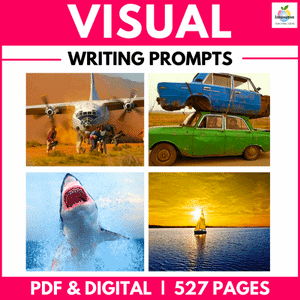
THE HAMBURGER ESSAY – THE STUDENT’S FRIEND

The common 5 paragraph essay structure is often referred to as the hamburger essay . And this is a memorable way to communicate the concept to your students.
The hamburger essay structure consists of five paragraphs or layers as follows:
Layer 1 – The Top Bun: The Introduction
The uppermost layer is the introductory paragraph which communicates to the reader the purpose of the essay.
Layers 2,3, & 4 – The Meat Patties: The Body Paragraphs
These are the meat patties of the essay and each paragraph makes an argument in support of the essay’s central contention as expressed in the introduction.
Layer 5 – The Conclusion: The Bottom Bun
The bottommost layer is the conclusion, where the arguments are summed up and the central contention of the essay is restated forcefully one last time. We have a complete guide to writing a conclusion here .
Soon, we’ll take a closer look at each of these parts in turn. But, there is more to an essay than just the writing of it. There are also the prewriting and post writing stages to consider. We will look at all these aspects in this article, but first, let’s examine what our students need to be doing before they even begin to write their essays.
A COMPLETE UNIT ON TEACHING PARAGRAPH WRITING
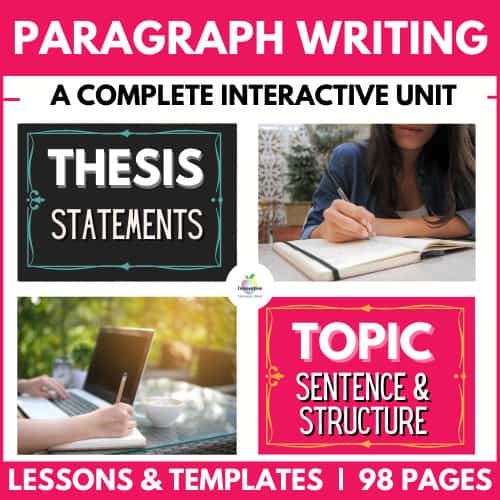
This complete PARAGRAPH WRITING UNIT takes students from zero to hero over FIVE STRATEGIC LESSONS to improve PARAGRAPH WRITING SKILLS through PROVEN TEACHING STRATEGIES.
THE PREWRITING STAGE – DEFINING THE THESIS STATEMENT, RESEARCH & PLANNING
The thesis statement.
Every essay needs a clear focus. This focus is usually defined in a thesis statement that presents the topic of the essay in a sentence or two. The thesis statement should also include the writer’s stance on that topic.
As this will help guide the direction of the essay, it is essential that our students define their thesis statement before they begin the writing process.
Sometimes during the process of writing, we find out what we think about a given topic. The writing process can act as a kind of reflection on the merits of the various arguments, before finally revealing to us our own opinion. This is writing as a method of discovery.
Usually, though, it is more efficient for students to decide on their opinions prior to beginning to write.
Defining their thesis statement early on not only helps guide the students writing, but helps ensure their research is focused and efficient at the crucial prewriting stage.
Research & Planning
As students begin their research and gather their evidence to support their thesis statement, they should also be encouraged to pay particular attention to the counterarguments they come across.
A well-written essay does not ignore opposing viewpoints, students should be taught to preempt counterarguments where possible so as to strengthen the power of their own arguments. Good research is essential for this.
Not so long ago, research meant hours in dusty libraries being constantly shushed, but with the advent of the internet, there is now a wealth of knowledge right at our fingertips (and the end of a good Wifi connection).
While this has made research a much more convenient process, students need to be reminded of the importance of seeking out reliable sources to support their opinions. In an era of ‘fake news’, this is more important now than ever.
As students gather the information and supporting evidence for their essay, they’ll need to organize it carefully. Graphic organizers are an effective way of doing this, either on a paper printout or by using a premade template on the computer.
It can also be helpful for students to sort their collected information according to where they intend to use it in the five-paragraph outline or layers mentioned above.
Finally, while good research, organization, and planning are essential for producing a well-written essay, it’s important that students are reminded that essay writing is also a creative act.
Students should maintain an open mind when it comes to the writing process. They should allow their thoughts and opinions the room to develop over the course of writing their essay. They should leave the door open for including new thoughts and ideas as the writing progresses.
The Writing Stage: Introduction, Body Paragraphs, & Conclusion
The introduction.
A good introduction paragraph serves a number of important functions. It:
- Grabs the reader’s attention and interest, known as the hook
- Orientates the reader to the essays central argument, the thesis statement
- Outlines briefly the arguments that will be explored in support of the thesis statement.
To become an effective writer, it is important that our students learn the importance of grabbing the reader’s attention, as well as keeping it. Opening with a ‘hook’ or a ‘grabber’ is a great way to achieve this.
There are a number of techniques students can use here. Let’s take a look at some of the more common ones.
- The Surprising Fact – this can intrigue the reader to want to find out more, especially if it challenges some of their existing assumptions on a topic.
- The Quotation – a carefully selected quotation can be a great way to secure the reader’s attention and there are many curated quotation collections freely available online to help get students started.
- The Joke – this opening should be used judiciously as for some topics it may not be an appropriate way to open. In the right context however, humor can be a great way to engage the reader from the outset.
- The Anecdote – anecdotes are a great way to personally connect with the essay’s topic. They are a helpful way of climbing down the ladder of abstraction when exploring more theoretical arguments. They assist the reader in relating universal themes to their own lives.
Practice Activity 1:
To encourage students to develop strong opening paragraphs in their essays, it can be helpful to isolate writing opening paragraphs.
In this activity, provide your students with a list of essay topics and challenge them to write four different opening paragraphs for their essay, one each for The Surprising Fact , The Quotation , The Joke , and The Anecdote as listed above.
When students have completed their four paragraphs, they can then share with each other in groups and discuss which worked best and why.
This activity will help students to remember the different types of opening and how they work. It will also give them a feel for which openings work best for different types of essays.
We’ve already discussed what a thesis statement is and what it is intended to achieve, but where does it fit into the overall shape of the introductory paragraph exactly?
While there are no hard and fast rules here, thesis statements work well towards the end of the introductory paragraph – especially as the paragraph’s final sentence.
Readers are often hardwired to look for the thesis statement there. It connects the arguments that follow in the body paragraphs to the preceding sentences and contextualizes the essay for the reader.
THE BODY PARAGRAPHS
Now we get to the ‘meat’ of our essay. Each of the body paragraphs will explore one of the arguments supporting the thesis statement as laid out in the introduction.
While we are focused on the 5 paragraph essay here, longer essays will usually be constructed in exactly the same manner, they’ll just include more body paragraphs to cover the extra level of detail.
Generally, each body paragraph will open by stating the argument, with subsequent sentences supporting that argument by providing evidence along with some further explanation. Finally, a statement or phrase will help transition to the next paragraph.
The PEEL Paragraph Writing Process
The acronym PEEL can be a very useful tool to help students to understand how to organize each of their body paragraphs.
P oint : start the paragraph by expressing the central argument
E vidence : support the central argument of the paragraph by providing evidence or reasons. Evidence may come in many forms including facts and statistics, quotations from a text or other authority, reference to historical events etc.
E xplanation : explain how the evidence provided supports the paragraph’s central argument.
L ink : provide a transition into the next paragraph by linking this argument and the central thesis to the next point to be made.

Practice Activity 2:
Just as students isolated the opening to their introductory paragraph for practice purposes, in this activity they’ll isolate a single argument on a chosen essay topic.
When they have chosen a topic and selected a single argument related to that topic, they can begin to write one body paragraph using the PEEL structure outlined above.
This activity works well when several students write on the same argument. When each has completed their paragraphs, they can then compare the results with each other.
It can be a fascinating experiment that allows the students to see just how diverse different treatments of the same argument using the same PEEL formula can be – there is freedom within the discipline of the structure!
THE CONCLUSION
The purpose of the conclusion is to close the circle of the essay. It is a chance for the writer to restate the thesis statement, summarize the main arguments, and tie up any loose ends as the writer drives home their point one last time.
At this stage of the game, no new arguments should be introduced. However, students should revisit the previous arguments made in the body paragraphs and it is acceptable to offer up a new insight or two on these.
The student should take care here to make sure they leave no doubt in the reader’s mind that the essay question is fully answered. One useful way of doing this is by incorporating words and phrases from the essay question into the conclusion itself.
To help students grasp the underlying structure of a concluding paragraph, the following sequential structure is useful to keep in mind:
- Starts with a closing phrase such as In conclusion , There is no doubt , Finally etc
- Restates the main thesis statement
- Summarizes the main point of each of the body paragraphs
- Leaves the reader with something to think about.
Practice Activity 3:
Again, here we will isolate the concluding paragraph for focused practice.
Students select a topic they know well, decide what they think about that topic, write down a few key arguments, and then begin writing a concluding paragraph to an essay on that topic.
Students should use the template above to structure that material.
You could also include an element of peer assessment here by having students swap their paragraphs with each other, before offering each other feedback.
The Post Writing Stage: Editing & Proofreading YOUR 5 paragraph ESSAY
The final stage of writing a five-paragraph essay is perhaps the least glamorous of an unglamorous process, but no less essential for it – the editing and proofreading.
Often, our students overlook this stage. After completing the process of research, planning, and writing their five-paragraph essay, they let themselves down at this final, crucial stage.
Frequently, students fail to adequately edit and proofread their work not just because of laziness, but because they are unsure of exactly what this process entails.
To avoid this, ensure students understand that editing and proofreading involve reading through and correcting mistakes in the following areas one after the other:
- Text Organisation: title, headings, layout etc
- Sentence Structure: coherence, grammar , sentence variety etc
- Word Choice: suitable word choices, avoid repetition etc
- Spelling and Punctuation: accuracy in both areas.
Practice Activity 4:
Once students have completed their essays, appoint each a partner to work with and each then edits and proofreads the other person’s work.
Sometimes students struggle to gain the necessary distance from their own work to adequately edit and proofread it, this exercise overcomes that issue while giving them an opportunity to gain some valuable editing and proofreading experience that will benefit them in future.
CLOSING THE CIRCLE
So, there you have it – how to write a five-paragraph essay from start to finish. As with anything, the more practice students get, the quicker they will improve.
But, bear in mind too that writing essays is hard work and you don’t want to put students off.
The best way to provide opportunities for students to develop the various skills related to essay writing is to isolate them in the manner apparent in the activities described above.
This way, students can soon sharpen up their skills, without learning to dread the word ‘essay’ itself!

Teaching Resources
Use our resources and tools to improve your student’s writing skills through proven teaching strategies.

Five Paragraph Essay exampleS (Student Writing Samples)
Below are a collection of student writing samples of 5 paragraph essays. Click on the image to enlarge and explore them in greater detail. Please take a moment to both read the 5 paragraph essay in detail but also the teacher and student guides which highlight some of the key elements of this structured model of essay writing here.
Please understand these student writing samples are not intended to be perfect examples for each age or grade level but a piece of writing for students and teachers to explore together to critically analyze to improve student writing skills and deepen their understanding of 5 paragraph essay writing.
We would recommend reading the example either a year above and below, as well as the grade you are currently working with to gain a broader appreciation of this text type.

5 PARAGRAPH ESSAY VIDEO TUTORIALS

- U.S. Locations
- UMGC Europe
- Learn Online
- Find Answers
- 855-655-8682
- Current Students
UMGC Effective Writing Center Secrets of the Five-Paragraph Essay
Explore more of umgc.
- Writing Resources
This form of writing goes by different names. Maybe you've heard some of them before: "The Basic Essay," "The Academic Response Essay," "The 1-3-1 Essay." Regardless of what you've heard, the name you should remember is "The Easy Essay."
Once you are shown how this works--and it only takes a few minutes--you will have in your hands the secret to writing well on almost any academic assignment. Here is how it goes.
Secret #1—The Magic of Three
Three has always been a magic number for humans, from fairy tales like "The Three Little Pigs" to sayings like “third time’s a charm.” Three seems to be an ideal number for us--including the academic essay. So whenever you are given a topic to write about, a good place to begin is with a list of three. Here are some examples (three of them, of course):
Topic : What are the essential characteristics of a good parent? Think in threes and you might come up with:
- unconditional love
Certainly, there are more characteristics of good parents you could name, but for our essay, we will work in threes.
Here's a topic that deals with a controversial issue:
Topic : Should women in the military be given frontline combat duties?
- The first reason that women should be assigned to combat is equality.
- The second reason is their great teamwork.
- The third reason is their courage.
As you see, regardless of the topic, we can list three points about it. And if you wonder about the repetition of words and structure when stating the three points, in this case, repetition is a good thing. Words that seem redundant when close together in an outline will be separated by the actual paragraphs of your essay. So in the essay instead of seeming redundant they will be welcome as signals to the reader of your essay’s main parts.
Finally, when the topic is an academic one, your first goal is the same: create a list of three.
Topic: Why do so many students fail to complete their college degree?
- First, students often...
- Second, many students cannot...
- Finally, students find that...
Regardless of the reasons you might come up with to finish these sentences, the formula is still the same.
Secret #2: The Thesis Formula
Now with your list of three, you can write the sentence that every essay must have—the thesis, sometimes called the "controlling idea," "overall point," or "position statement." In other words, it is the main idea of the essay that you will try to support, illustrate, or corroborate.
Here’s a simple formula for a thesis: The topic + your position on the topic = your thesis.
Let’s apply this formula to one of our examples:
Topic: Essential characteristics of a good parent Your Position: patience, respect, love Thesis: The essential characteristics of a good parent are patience, respect, and love.
As you see, all we did was combine the topic with our position/opinion on it into a single sentence to produce the thesis: The essential characteristics of a good parent are patience, respect, and love.
In this case, we chose to list three main points as part of our thesis. Sometimes that’s a good strategy. However, you can summarize them if you wish, as in this example:
Topic: Women in combat duty in the military Your Position: They deserve it Thesis: Women deserve to be assigned combat duty in the military.
This type of thesis is shorter and easier to write because it provides the overall position or opinion without forcing you to list the support for it in the thesis, which can get awkward and take away from your strong position statement. The three reasons women deserve to be assigned combat duties--equality, teamwork, courage--will be the subjects of your three body paragraphs and do not need to be mentioned until the body paragraph in which they appear.
Secret #3: The 1-3-1 Outline
With your thesis and list of three main points, you can quickly draw a basic outline of the paragraphs of your essay. You’ll then see why this is often called the 1-3-1 essay.
- Supporting Evidence for Claim 1
- Supporting Evidence for Claim 2
- Supporting Evidence for Claim 3
The five-paragraph essay consists of one introduction paragraph (with the thesis at its end), three body paragraphs (each beginning with one of three main points) and one last paragraph—the conclusion. 1-3-1.
Once you have this outline, you have the basic template for most academic writing. Most of all, you have an organized way to approach virtually any topic you are assigned.
Our helpful admissions advisors can help you choose an academic program to fit your career goals, estimate your transfer credits, and develop a plan for your education costs that fits your budget. If you’re a current UMGC student, please visit the Help Center .
Personal Information
Contact information, additional information.
By submitting this form, you acknowledge that you intend to sign this form electronically and that your electronic signature is the equivalent of a handwritten signature, with all the same legal and binding effect. You are giving your express written consent without obligation for UMGC to contact you regarding our educational programs and services using e-mail, phone, or text, including automated technology for calls and/or texts to the mobile number(s) provided. For more details, including how to opt out, read our privacy policy or contact an admissions advisor .
Please wait, your form is being submitted.
By using our website you agree to our use of cookies. Learn more about how we use cookies by reading our Privacy Policy .
Five Paragraph Essay Outline
10 May, 2020
7 minutes read
Author: Tomas White
The five paragraph essay exists as one of the most commonly assigned essays, especially for high school students. In fact, the five paragraph essay format is so popular, it is often used not only in the classroom but for exams and admission essays as well. If you’ve never written a five paragraph essay, or find that you simply need a good refresher, you’ve come to the right place! We have thrown out all the useless information and boiled it down to the essential info you need to both understand what a five paragraph essay is and how to write one to earn the grade you want.

What is a Five Paragraph Essay?
Unlike some misleading names, the five-paragraph essay is exactly what it sounds like: an essay that consists solely of five paragraphs. This type of essay is strictly about the structure. That’s what matters much more than the topic or questions to be discussed in the essay. The paragraphs in the essay paragraphs follow a very specific outline.
This kind of essay was separated from all other types with a sole purpose – teaching students about the concept of the essay by practicing it’s most basic structure variant. Even though any kind of essay can have five paragraph – from a definition essay to story-based narrative essay ; five paragraph essay is never limited to the approach. It might look like any other essay, but the structure is the king here.
Meet the Five Paragraph Essay Outline
This type of essay contains three distinctly different kinds of paragraphs including (in order):
- Introduction paragraph
- Three body paragraphs
- Conclusion paragraph
While all three types of paragraphs follow traditional grammar and syntax conventions, what goes into each paragraph varies based on its purpose.
Let’s take a look at what makes each of these paragraphs unique:
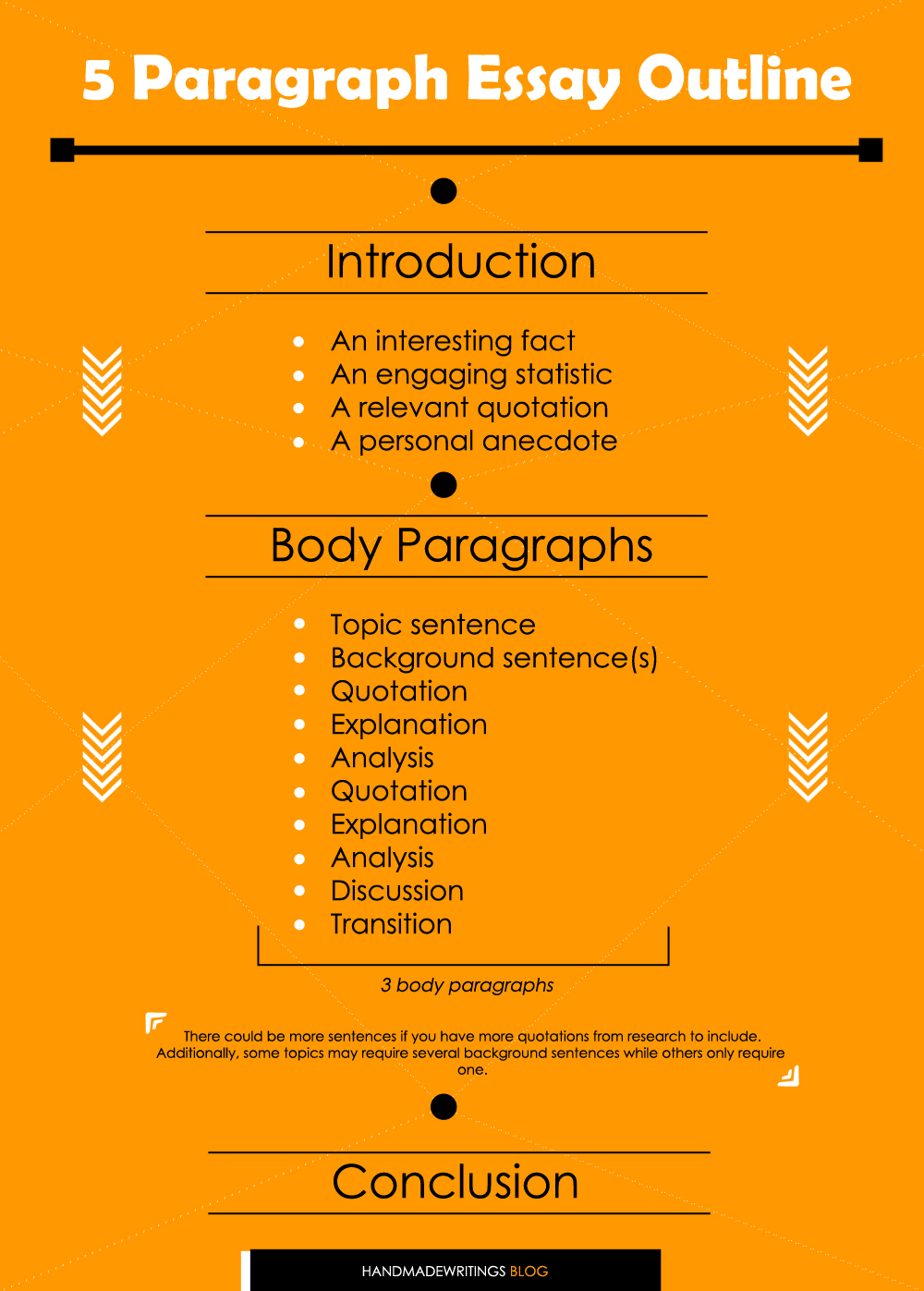
Introduction
The introduction paragraph should have three key parts: an attention getter , background information , and a thesis statement . These elements should appear in this order; the thesis statement typically appears as the last sentence in the introduction because it acts as a transition to the body paragraphs which each work to support the argument outlined within the thesis. Let’s say that the topic of your five paragraph essay is the best type of pet to own. After doing some research, you decide to write about cats. The attention getter sentence should capture the audience’s attention and make them want to read more about cats. Attention getter sentences often fall into one of four categories:
- An interesting fact
- An engaging statistic
- A relevant quotation
- A personal anecdote
It’s important to note that a personal anecdote or story from your own life may not be appropriate for all types of essays — especially if an instructor has noted that no personal pronouns be used in the paper.
Related post: How to write an Essay introduction
After gaining the audience’s interest, the next few sentences, anywhere from 3 to 10 sentences, depending upon the essay, should be about background information. Such information may define specific vocabulary or generally provide background information relevant to the topic.
In a five-paragraph essay about cats, relevant background information could include when cats became domesticated, how many breeds of cats are available today, and where individuals can find cats as pets.
Finally, the last part of the introduction paragraph should be the thesis statement. A well-written thesis statement should include an argument and a roadmap on how to prove it.
In this case, a simple yet effective thesis statement could be: “Cats make the best pets because they are intelligent, friendly, and sociable.” The first part, “cats make the best pets” is the argument while the second part, “intelligent, friendly, and sociable” is the roadmap. This is called a roadmap because it outlines the ideas that will guide the paper in the body paragraphs.
According to this thesis statement, there will be a body paragraph that provides evidence that cats are intelligent, another proving that cats are friendly, and a third proving that cats are sociable.
Stuck on writing your outline? Our essay writer will help You!
Body Paragraphs
A typical body paragraph is anywhere from six to twenty sentences; the length of a body paragraph depends upon the amount of research, analysis, and discussion needed in each paragraph to support the argument set forth in the thesis statement. Typically, a body paragraph will follow an organization such as this:
- Topic sentence
- Background sentence(s)
- Explanation
There could be more sentences if you have more quotations from research to include. Additionally, some topics may require several background sentences while others only require one.
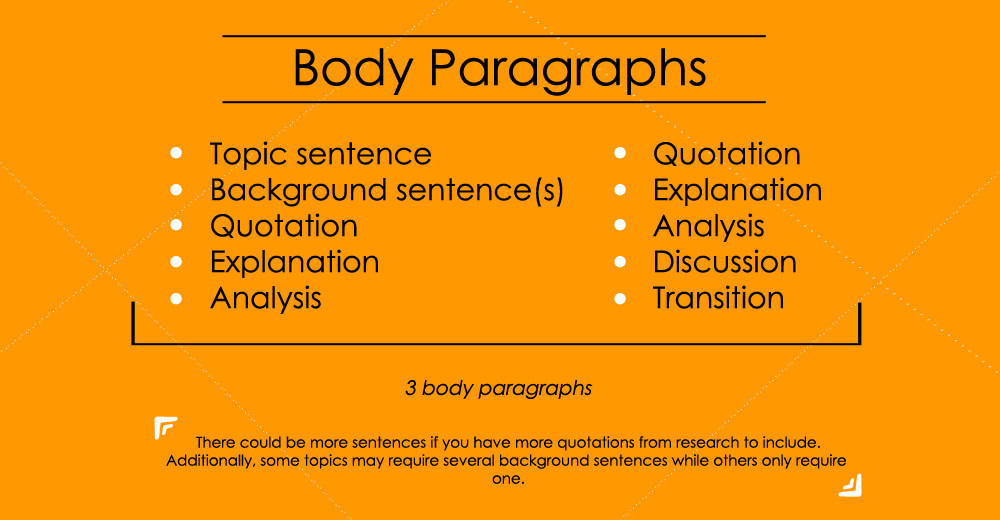
Remember: value your time and your teacher’s time; skip writing sentences to pad the length of your paper and ask yourself if each sentence contributes to proving the argument outlined within the thesis. If the sentence doesn’t, get rid of it!
The conclusion paragraph should be the final paragraph in the paper. It is often the shortest paragraph. Its purpose is to review the main points and prove to the audience that the writer has successfully argued his or her point. A conclusion paragraph should never introduce any new information. Most teachers prefer students to skip obvious phrases such as “In conclusion” or “Before ending” because these statements are understood by the reader.
Related post: Cause and Effect essay outline
Following the conclusion paragraph, you will likely need to create a “Works Cited” and/or a “Bibliography” page if you included any type of research within the five paragraph essay outline. After each quotation or paraphrase in the essay should be a parenthetical citation, and each parenthetical citation should be referenced in the Works Cited and/or Bibliography page. Your teacher or professor should clearly communicate their preference; a Works Cited page exists as a reference for all the works quoted in the essay whereas the Bibliography page lists every source you consulted during the research process.

Tips and Tricks
If writing isn’t one of your favorite requirements of academic life, check out these 10 tips and tricks to navigate creating a five paragraph essay smoothly:
- Begin early
- Make an appointment with the teacher to discuss your ideas/progress and get feedback
- Take good notes, and cite the sources as you go
- Create a sentence outline before the draft
- Edit the essay twice: once for content, once for grammar
- Get at least one other person to provide constructive criticism
- Make an appointment at the Writing Center if your campus has one
- Hire a professional editing service to catch pesky grammar errors
- Review the final essay against any provided rubric item by item
- Check the paper’s formatting for spacing, margins, and headers/footers
Writing assignments are never sprints, but they don’t have to be marathons either — try to find a happy medium!

A life lesson in Romeo and Juliet taught by death
Due to human nature, we draw conclusions only when life gives us a lesson since the experience of others is not so effective and powerful. Therefore, when analyzing and sorting out common problems we face, we may trace a parallel with well-known book characters or real historical figures. Moreover, we often compare our situations with […]

Ethical Research Paper Topics
Writing a research paper on ethics is not an easy task, especially if you do not possess excellent writing skills and do not like to contemplate controversial questions. But an ethics course is obligatory in all higher education institutions, and students have to look for a way out and be creative. When you find an […]

Art Research Paper Topics
Students obtaining degrees in fine art and art & design programs most commonly need to write a paper on art topics. However, this subject is becoming more popular in educational institutions for expanding students’ horizons. Thus, both groups of receivers of education: those who are into arts and those who only get acquainted with art […]

How to Write a 5 Paragraph Essay: Outline, Example

Imagine this:
You have to write your first essay, but you’re not sure where to start. You have a hundred questions , and more are coming to you every minute, but you’re afraid to ask the teacher for help.
What’s the difference between an argumentative essay and an informative essay? How will I be graded? What must I include? The list goes on. Well, first, take a breath. Before you tackle different essay varieties, grading rubrics, and the bullet points of exactly what should go in your essay, you need to make sure you understand structure. The 5 paragraph essay format is a classic example of an essay, and once you know how to create a 5 paragraph essay outline, you can write any essay that’s assigned to you.
Perfecting the art of essay writing is not only essential for acing your assignments but also for securing financial support as you transition from high school to college. A well-structured essay, such as the 5-paragraph essay, showcases your writing prowess and your ability to articulate ideas in a coherent and compelling manner. As you master the formula of a 5-paragraph essay, consider leveraging these skills to apply for scholarships. Numerous scholarships are specifically geared towards high school seniors, offering a financial launching pad for your college adventure. Discovering the best scholarships to apply for high school seniors can provide you with the resources you need to pursue your academic endeavors. The skills you hone while crafting precise and impactful essays will serve you well as you embark on the exciting journey of drafting scholarship essays, each one a stepping stone towards your higher education and a bright future.
The 5 Paragraph Essay Outline
Don’t know the 5 paragraph essay structure? It’s pretty simple. Here’s the basic outline you should follow:
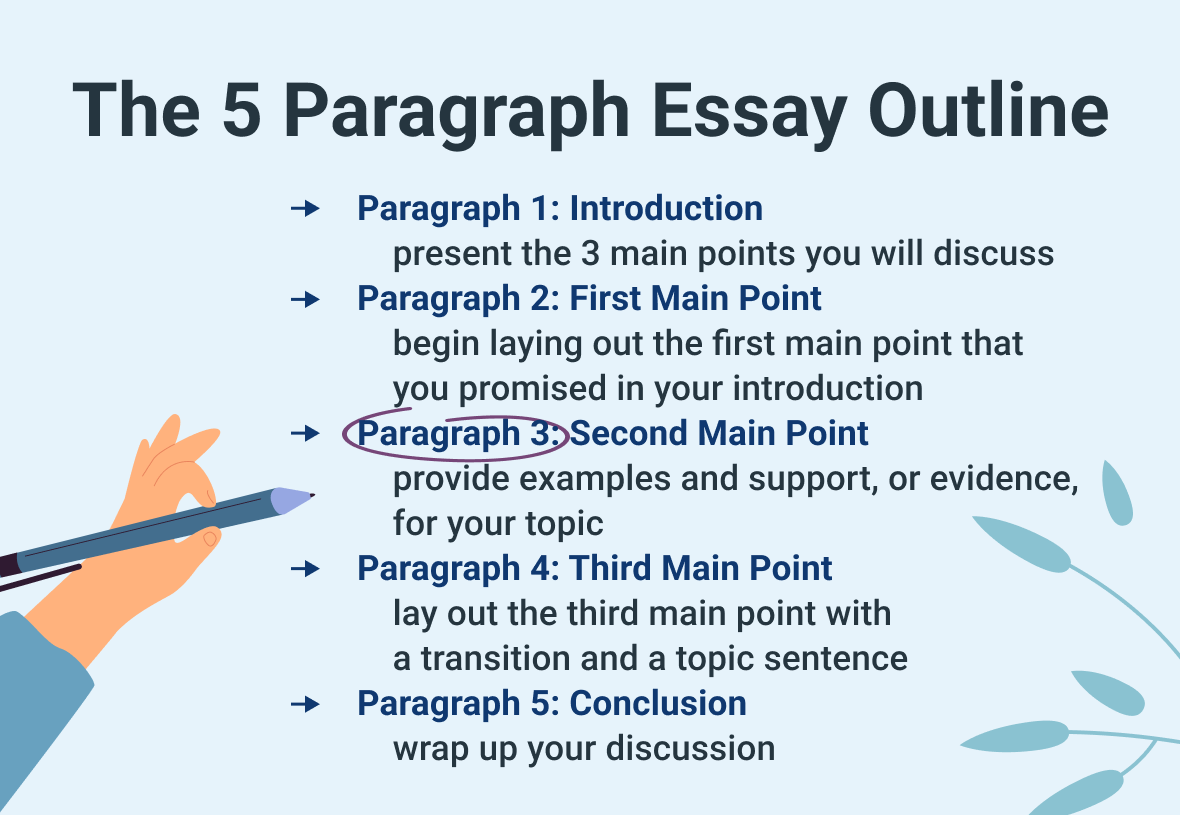
Now let’s discuss what should go in each paragraph. The following 5 paragraph essay template by our service should tell you exactly what you need to do to complete your assignment.

Paragraph 1: Introduction
In the introduction, you should provide background information on your topic. Usually, this information should be factual, especially for a history paper, but you can be creative in how you present it. The key is that you want to intrigue the reader. You want to draw the reader into your topic by creating a natural curiosity about it.
Somewhere in the middle of your introduction, you need to present the 3 main points you will discuss in your 5 paragraph essay . These 3 points are crucial for the basic essay, as you need to ensure you have enough to talk about, and it’s best to introduce them in the first paragraph. However, keep in mind that as your essays get longer, you may need to use more than 3 main points. That’s not something you should worry about now, though.
In any essay, your introductory paragraph should end with a strong thesis statement that tells readers exactly what you aim to prove. If the essay is meant only to inform, the thesis statement should clarify to readers exactly what you’re going to inform them of.
Paragraph 2: First Main Point
The second paragraph is where you begin laying out the 3 main points that you promised in your introduction. In this paragraph, the first sentence should transition from the previous paragraph to the current one. It should also clearly introduce the topic, your first main point.
The sentences that follow should provide examples and support, or evidence, for your topic . Readers should see that every example and every piece of support you provide (e.g., quotes, graphs, paraphrased information) is connected to your topic. They should never be left wondering why you included something.
Paragraph 3: Second Main Point
The third paragraph of your 5 paragraph essay is where you lay out the second main point. As the previous paragraph, it should begin with a transition and a description of the topic you’re about to discuss. Any examples or support you provide should be related to the topic at hand.
Paragraph 4: Third Main Point
The fourth paragraph is where you lay out the third main point that you promised in your essay’s introduction. Like any paragraph, it should have a transition and a topic sentence, and any examples or support should be related and interesting.
Paragraph 5: Conclusion
The last paragraph of a 5 paragraph essay — or any length should be a conclusion . It should not present new information, but it should always wrap up your discussion. One way to conclude is to summarize your 3 main points and then leave the reader with some key takeaways or a final thought about your thesis that drives your essay home.
However, your essay should not end with a cliffhanger. Remember that idea of cohesion? When the reader finishes your essay, he or she should feel like the information or argument is complete and fascinating.
Creating the 5 Paragraph Essay Graphic Organizer
Now that you understand the 5 paragraph essay format, it’s time to begin planning and writing your essay. To do that, custom writing professionals suggest using a graphic organizer. It can be a simple outline in bullet points, or it can be more visual in nature.
For example, you can create a mind map with your thesis idea — or even the whole thesis sentence — in the middle. Circle your thesis. From there, you can draw lines from the thesis outward and create new bubbles for your mind map, perhaps showing the main points you intend to discuss. Your mind map can include any information that’s helpful, and you may find that you want to expand on each main point with new bubbles.
PRODUCTION: Create a simple drawing of a mind map. Put the word “Thesis” in the middle (circled), and then put the words “Point 1,” “Point 2,” and “Point 3” around it. Draw circles around those words, and connect them to “Thesis” using lines. See example below.
Don’t spend too much time creating a graphic organizer, though. At some point, you need to start writing your 5 paragraph essay! Then the real fun begins. Read more on how to reference an essay

The 5 Paragraph Essay Rubric
If you’re wondering how your essay will be graded, you’re not alone. While the exact rubric your teacher uses will vary, here’s a basic one that may help you see what’s expected in your essay.
Grade A: Excellent
- Both introduction and thesis are strong.
- Details and examples are strong and well organized.
- The conclusion is strong enough.
- Grammar is correct.
Grade B: Good
- Has some spelling and grammar errors.
Grade C: Fair
- The introduction is good, but the thesis is weak.
- Examples used are weak.
- The conclusion is weak.
- Has major spelling and grammar errors.
Grade D: Poor
- Introduction and thesis are weak.
- Details and examples are weak and somewhat unorganized.
- Details or examples are few.
- Does not have a conclusion.
- Has serious spelling and grammar errors.
Grade F: Unsatisfactory
- Does not contain a thesis, and introduction is weak.
- Details and examples are weak and have no clear organization, or there are none at all.
In some cases, your teacher may give you a rubric before you start your essay. If so, make sure you read it carefully and don’t be afraid to ask questions if you don’t understand something. The rubric should tell you exactly what the teacher is looking for, whether it’s a 5 paragraph essay or something much longer. To succeed with your task, please find some essay writing tips .
5 Paragraph Essay Sample
Below you can find free 5 Paragraph essay sample called " The Impact of Technology on Education ".
"In today's rapidly advancing world, technology has become an integral part of our daily lives, revolutionizing various sectors, including education. Its influence on the way we learn, teach, and interact with educational materials is undeniable. This essay examines the significant impact of technology on education, highlighting its benefits and exploring real-life examples that illustrate its transformative power.
One of the primary benefits of technology in education is the enhanced accessibility to information. The internet has brought a wealth of knowledge right to our fingertips. Students can now access a vast array of educational resources, such as e-books, online articles, and interactive learning platforms. For instance, platforms like Khan Academy provide video tutorials and practice exercises on various subjects, enabling students to learn at their own pace and revisit concepts as needed. Furthermore, online forums and discussion boards foster collaborative learning, connecting students and educators from around the globe to share ideas and insights.
Another key advantage of technology in education is its ability to promote active and personalized learning. With the advent of educational software and applications, students can engage in interactive activities that cater to their individual needs and learning styles. For example, adaptive learning platforms like Duolingo tailor language lessons based on the learner's proficiency level and progress. This personalized approach helps students stay motivated and enhances their comprehension and retention of the material. Additionally, digital simulations and virtual reality tools provide immersive learning experiences, allowing students to explore complex concepts in a hands-on and engaging manner.
Furthermore, technology has revolutionized the way educators deliver instruction and assess students' progress. Online learning management systems, such as Moodle and Canvas, enable teachers to create and share course materials, assign tasks, and provide timely feedback. These platforms streamline administrative tasks, giving educators more time to focus on designing innovative lessons and individualized support for students. Moreover, digital assessment tools offer immediate feedback, enabling students to track their progress and identify areas for improvement. Platforms like Kahoot! and Quizlet make learning enjoyable by incorporating gamification elements, making the assessment process interactive and engaging.
In conclusion, technology has had a profound impact on education, transforming the way we learn and teach. The accessibility to vast amounts of information, the promotion of active and personalized learning, and the innovative methods of instruction and assessment are just a few examples of the positive effects of technology in education. However, it is important to ensure that technology is used as a tool to enhance learning rather than replace traditional teaching methods. As we continue to embrace technological advancements, it is crucial to strike a balance between leveraging its benefits and maintaining the human element in education. By doing so, we can harness the full potential of technology to create a future where education is accessible, engaging, and empowering for all learners."
Final Thoughts on the 5 Paragraph Essay
Once you’ve mastered the format of the 5 paragraph essay, you can write a paper at any length imaginable. Remember that it’s helpful to create an outline or graphic organizer to organize your ideas before you start writing , especially for a longer essay. If you have a rubric ahead of time, you’ll know exactly what you need to watch out for as you edit and polish your paper.

With the above information at your disposal and a rubric in-hand, you should have no excuses for a poor grade. Just be mindful of how much time you have to work, and break the writing into small chunks if you need to. Always start early to get the best grade possible.
Still not sure how to write a good 5 paragraph essay? You can order a high-quality custom essay from us or just take advantage of our top-notch paper editing and rewriting services. So in other words, we’ll write your essay from scratch, write a new draft, or just clean up the draft you’ve already written. Whatever you need to finish your writing and get an excellent grade, you can buy it right here. Check out our reviews if you want to see what some happy customers have said.
Frequently asked questions
She was flawless! first time using a website like this, I've ordered article review and i totally adored it! grammar punctuation, content - everything was on point
This writer is my go to, because whenever I need someone who I can trust my task to - I hire Joy. She wrote almost every paper for me for the last 2 years
Term paper done up to a highest standard, no revisions, perfect communication. 10s across the board!!!!!!!
I send him instructions and that's it. my paper was done 10 hours later, no stupid questions, he nailed it.
Sometimes I wonder if Michael is secretly a professor because he literally knows everything. HE DID SO WELL THAT MY PROF SHOWED MY PAPER AS AN EXAMPLE. unbelievable, many thanks
You Might Also Like

New Posts to Your Inbox!
Stay in touch
How To Write A Five Paragraph Essay?
Table of contents
- 1 What is a five-paragraph essay?
- 2 Types of 5-Paragraph Essay
- 3 How to start a five-paragraph essay
- 4.1 Thesis Statement
- 5.1 Introductory paragraph
- 5.2 Body paragraphs
- 5.3 Transitioning between paragraphs
- 5.4 Concluding paragraph
- 6 Outline for a Five-Paragraph Essay
- 7 Tips On How To Prepare A Successful Five-Paragraph Essay
- 8 Conclusion
Today we are about to talk about 5-paragraph essays. The structure of such work is quite easy and uncomplicated. However, students still have questions about how to perform this task most effectively. Let’s take a closer look at how to organize your essay correctly, the basic requirements, and writing tips. This post from Papersowl will answer all your questions and help you write an outstanding paper.
What is a five-paragraph essay?
The first question to answer is what is a five-paragraph essay. This is an essay template that helps students structure a good paper . The structure consists of an opening paragraph, followed by three supporting body paragraphs and a concluding paragraph. This writing style is also called a hamburger essay.
This type of presentation of thought allows the student to structure their thoughts easily and put them on paper with the maximum level of specificity. The brevity and organization of such a text cause its great popularity in educational assignments and exams like SAT, EILTS, and TOEFL.
Such a format is easy to explain to students, and it does not take them much time to delve into the requirements and write an essay . A five-paragraph essay format is short and is often restricted to between 250-750 words. When writing such an essay, you can apply different styles and artistic techniques to different topics and contexts. This answers the question of how many words is a 5 paragraph essay.
Types of 5-Paragraph Essay
- An argumentative essay displays a subject from a certain point of view and presents advantages over others.
- A definition essay defines an idea, concept, or premise and adds a personal interpretation along with the official one.
- An expository essay is used to expose or reveal information that wasn’t obvious.
- A persuasive essay is constructed to persuade the reader to believe or act in a certain way.
- Descriptive essays use many adjectives to encourage readers to feel, experience, and visualize a subject.
- Other types of five-paragraph examples include comparing and contrasting multiple topics and explaining cause and effect . You can also use it to evaluate or critique a piece of fiction. Generally, the five-paragraph essay format is suitable for all essay types.
How to start a five-paragraph essay
To start working on a five-paragraph essay, as well as on other types of written work, you should first study the topic. The theme can relate to completely different areas of activity as the format allows it. Then it would help if you worked on an outline of the essay and the main ideas you would like to include in your writing. The 5 paragraph essay outline is like a plan to help you understand in advance how to write a 5 paragraph essay.
- Remember that a 5-paragraph essay consists of an introduction, supporting paragraphs, and a conclusion. Three supporting paragraphs will clarify, support, and prove your thesis.
In the first paragraph, you should include introductory information that informs the reader. Express your thoughts clearly so that your essay is easy to read. Try to grab the reader’s attention so that they want to continue reading your essay with great interest. A good first paragraph sets the mood for what follows, so be very particular about it.
Choosing a 5-Paragraph Essay Topic
Choosing a topic for a five-paragraph essay is always difficult when it falls on a student’s shoulders. If you have the opportunity to choose a topic from the list, choose one that will be easy to develop in three paragraphs. Pick a topic that you are interested in or understand, and then it will be easier for you to come up with three different ideas. Suppose you are interested in computer games and choose a topic related to their impact on school-age children. Describe in three paragraphs three arguments for which computer games can be helpful for the intellect and socialization of a student.
Whatever topic you choose, ensure you have enough expertise, creativity, and personal conviction to get your point across. This is very important because each paragraph should be filled with meaning. It is also a useful feature to write a sentence that briefly describes the idea of your five-paragraph essay.
Try to avoid choosing overused topics, as they have been discussed many times already, and you are unlikely to be able to bring any novelty. The best topic is one you feel so excited about and can discuss with your friends for hours without getting tired. You can save yourself the stress by selecting write essays for me on a writing service website. Professionals will write an excellent piece for you on tight deadlines and with the highest quality possible.
Thesis Statement
A thesis statement is a sentence that describes the topic your essay will focus on. It is essential to make it as informative as possible, even with a limited number of words. A good thesis statement will briefly express your primary thoughts in the main part. It is also well suited for summing up intermediate results.
The thesis statement can be something other than the first sentence in your paper. However, it must be in the introduction. The ideal place to place the statement is at the end or middle of the introduction.
✏️A good thesis example:
Most American parents believe that computer games have a detrimental effect on the development of their school-age children. Still, a series of studies have been conducted that have proven otherwise. Children fond of computer games have better memory, faster mental arithmetic, and good communication skills.
This thesis statement example lists the three points we intend to elaborate on in the body. So, introduction, supporting paragraphs about the three points, and conclusion. Without any extra help, you can already imagine this essay topic.
5 Paragraph Essay Structure
- Opening paragraph: this paragraph should contain the main topic of the essay and a list of the main ideas that will be discussed.
- This segment is considered the main one because it contains the entire message of the composition.
- Concluding paragraph: Summing up and analyzing the information presented are in the concluding paragraph.
Remember when we said at the beginning of the article that a 5-paragraph essay is also called a hamburger essay? We need to imagine a hamburger to remember and understand the structure of such an essay. Assume the top bun is the introduction and that the three supporting body paragraphs are your meat patties. Finally, the bottom bum is the conclusion.
This part of the article allowed you to get acquainted with a five-paragraph essay format. For a more comprehensive analysis, let us examine the types one after the other.
Introductory paragraph
The first question is,” How long should an introductory paragraph be ?” The size is quite restricted. As we have already said, the main task of the introduction is to hook the reader and also let him understand what exactly the essay will be about. This is why the question should be carefully studied, and an exciting opening for the text should be prepared. Here are some things you can do to secure an excellent introduction:
- Make it catchy The introduction should catch the reader’s attention. To do this, we recommend you start with a provocative question, striking fact, or a bold statement. Surprise is a guarantee that you will be noticed. Surprise is a challenge to the reader’s expectations. If you surprise the readers at the very beginning of your story, you will capture their minds and attention.
- Be an innovator Our nervous system tends to look for novelty in everything. Any reader wants to see in your text something that they did not know before and that they had yet to read about before. Try to bring novelty to your text, providing the reader with interesting information.
- Be brief The size of the introductory paragraph is limited; you will have to fit the desired meaning into a short space. Try to be concise and explain your thoughts as clearly and understandably as possible.

Body paragraphs
While the introduction is only the beginning, the main part is where you should state your primary thoughts and ideas, backing them up with arguments and evidence. Unlike the first paragraph, where you had to be brief in the main body, you should expand your thoughts and explain your point of view.
Every paragraph in this part should present a separate statement, consolidated with particular facts and your personal ideas on the point. Therefore, start each paragraph with a fresh description of a single thought. Be objective, and don’t include irrelevant details.
Here is an idea for the body section:
- Use an introductory sentence.
- Follow it with a supporting argument or explanation. You can use various evidence like statistics, quotes, examples, and facts to show why you feel the sentence is true.
- Conclude the sentence.
Now you have an idea of how to organize a paragraph in the body, and you need to compose two more in the same way.
Let’s use the example we stated earlier in our thesis. We wish to argue that equipment failures, wildlife encounters, and bad weather can make tent camping a frustrating experience.
Introduction – hook statement, background information, thesis. Use these tips for writing the body paragraph:
- 1st paragraph (strongest argument) – topic sentence, claim, evidence, concluding statement
- 2nd paragraph (weakest argument) – Topic sentence 2, claim 2, evidence, concluding statement.
- 3rd paragraph (strong or persuasive argument) – Topic sentence 3, claim 3, evidence, general concluding statement.
Transitioning between paragraphs
An incredibly important part of any statement is the consistency and interconnectedness of the components in the letter. You must use transition techniques for your thoughts to be clearly stated and connected. For example, transitional sentences help the author smoothly change the topic without leaving a clear boundary.
Transition sentences show the relationship between two or more ideas. They are like bridges that connect your ideas and are made up of words or phrases. Words you can include in each paragraph are: “finally,” “simultaneously,” “for example,” “to illustrate,” “In fact,” “likewise,” “similarly,” “nevertheless,” and “on the contrary,” “in contrast,” “on the other hand,” “furthermore,” “consequently,” “therefore,” etc. There are tons of transition phrases you can use, and it will help if you check out tips for writing transition sentences.
Concluding paragraph
The essence of the final paragraph is to summarize everything that has been said above. Remember that the conclusions should be directly related to what you talked about in your essay. You also need to create such an effect that if a person reads only the introduction and conclusions, the reader will still understand what was discussed in the text.
Summarize a couple of sentences in which you clearly describe the conclusion you came to while writing the essay. In other words, state the content of the text in words understandable to the reader.
Outline for a Five-Paragraph Essay
Combining everything we’ve learned so far, the five-paragraph essay structure should look like this:

To summarize, this essay outline is the most common and in the vast majority of cases, the most effective. It’s a great way for amateurs to sharpen their writing skills and writers of any level can utilize this whenever in doubt. We hope you make use of the above-established template to propel your essays to the next level.
Tips On How To Prepare A Successful Five-Paragraph Essay
- Be concise and concise in presenting your thoughts without going off-topic.
- Come up with an interesting and attractive title for your essay.
- Work on a good introduction to immediately interest the reader.
- Write a thesis statement that will help lead the reader in and improve the structure of your essay.
- Create an outline to make your work easier. An essay outline will save you time and communicate what the entire essay should include when you are done.
- Take your time submitting an essay several times, and check the text for spelling, punctuation and stylistic errors. Pay attention once again to the structure, whether you missed anything, and whether all five paragraphs are in place. Check out tips on how to write a college essay and use various resources to ensure the best result.
- Reread your work and consider whether it is creative and innovative enough. The reader will be interested in reading unknown information.
- Change your argument if you discover that the body paragraph does not align with your thesis.
At the end of this article, we want to summarize and list the main information we have shared with you. The 5-paragraph essay structure needs to contain an introduction, the node part consisting of 3, and a final paragraph. The format of such an essay stays the same depending on the topic, and the word count ranges between 250-750 words. You don’t have to be a professional to be able to write a five-paragraph essay. Be patient and creative and get down to business: come up with an interesting title, develop an outline, write the body and summarize your essay. Remember to be innovative and express your point of view by showing your intelligence and creativity. If needed, there are also experienced writers for hire who can help you bring your essay to life.
Readers also enjoyed

WHY WAIT? PLACE AN ORDER RIGHT NOW!
Just fill out the form, press the button, and have no worries!
We use cookies to give you the best experience possible. By continuing we’ll assume you board with our cookie policy.
How to Write a 5-Paragraph Essay: Outline, Examples, & Writing Steps
If you wish a skill that would be helpful not just for middle school or high school, but also for college and university, it would be the skill of a five-paragraph essay. Despite its simple format, many students struggle with such assignments.
Our specialists will write a custom essay specially for you!
A 5-paragraph essay structure consists of an introductory paragraph, three body paragraphs, and a concluding paragraph. It is one of the fundamental techniques for primary English education. It is also used to test the level of knowledge in almost any humanities subject.
- 👣 7 Writing Steps
- 📝 Essay Examples
🔗 References
📑 5-paragraph essay outline.
This genre is probably the most structured type of writing. It starts from a broad explanation and definitions, continues with narrow argumentation, and finishes with another broad generalization. The Hamburger Format can help you memorize the step-by-step essay structure .

Top Bun: Five-Paragraph Essay Introduction
The first sentence is usually a hook . It may be a rhetorical question, a stunning fact, or an example from real life. Its purpose is to make the reader interested in what’s going to come next.
It is hard to recollect that some 20 years ago, cell phones used to be a luxury.
Then you are supposed to provide a “ trailer for the movie :” hint what you are going to talk about, without revealing the plot. Two or three sentences will suffice.
Secondary school teachers can tell the children to put away their gadgets, but this practice becomes hardly possible at college, where adult people are taught.
The last sentence of an introduction is a thesis . It introduces your message to the reader and is usually arguable.
Just in 1 hour! We will write you a plagiarism-free paper in hardly more than 1 hour
This essay explores why it is morally permissible to introduce cell phone control at colleges and what results it may entail.
5-Paragraph Essay Body
Lettuce: paragraph #1.
- The first paragraph should provide the most prominent and substantial argument .
- Start each paragraph with a topic sentence . It links your ideas to the thesis statement. If at some point, you realize that there is a discrepancy between your topic sentences and the thesis, you should update the latter.
- Then comes the evidence or explanation . Avoid generalizations here. Defend your argument in the most concise manner. If any words could be left out, they should be deleted.
- Finish each paragraph with an analysis : how does it refer to your thesis?
Tomato: Paragraph #2
The second and third paragraphs follow the same structure. Your “tomato” argument is the weakest and less evident than the first one.
Burger: Paragraph #3
Dedicate the last paragraph to the most persuasive claim. In an argumentative essay, the third paragraph dwells upon the opposing opinion, substantiating its wrongness.
Bottom Bun: Five-Paragraph Essay Conclusion
A conclusion intends to summarize the main body paragraphs and restate the thesis in different words. The last sentence of your conclusion should indicate that the text is over.
Having considered everything mentioned above, it shall be stated that the use of telephones ruins the learning process and should be controlled.
5-Paragraph Essay: Outline Template
To simplify the outline above, feel free to use the following 5-paragraph essay template. It will do for any essay length.
- “movie trailer”
- thesis statement
- topic sentence
- allusion to thesis
- overall concluding sentence
How Many Words Is a 5-Paragraph Essay?
A typical five-paragraph essay is 500 to 1000 words long . However, for easy writing, the average of 250 to 500 words is admissible. This word count should be distributed among the introduction, three body paragraphs (each consisting of a topic sentence and at least three evidence sentences), and the conclusion.
Receive a plagiarism-free paper tailored to your instructions. Cut 20% off your first order!
👣 How to Write a 5-Paragraph Essay: 7 Steps
Step 1. choose your 5-paragraph essay topic.
As a rule, the teacher provides the topic or at least the scope of topics in the assignment. However, it may happen that you will have to come up with your own theme. To avoid changing the title in the course of writing and starting the whole work from the beginning, make sure you observe the following rules:
- Avoid overused subjects if you don’t want half of your classmates to have similar essays.
- Try to find a narrow topic that suggests an argument.
- The best topic is the one that you would argue with your friend for hours . If you feel excited thinking about it, your readers will enjoy learning about your opinion.
Step 2. Create Your Thesis Statement
Simply put, the thesis statement is the point of your essay. A well-developed thesis statement is a one- or two-sentence summary of what your essay shows and how it shows it. In other words, it should outline the points that will be made in your body and indicate the conclusion made from those points.
A thesis statement is the centerpiece of your essay. And this is why writing a thesis statement should happen first . It shouldn’t be the first sentence of your essay, but it must be in your introduction. Ideally, the thesis statement should be tucked into the middle or end of the first paragraph while writing essay introductions.
Here are a few thesis statement examples to make sure you understand the idea:
Thesis Statement Example #1
“There are many organic foods available today, but the vast majority of conventional foods can be eaten without any concern about the consumption of toxic pesticides. This is because many foods are not grown with pesticides, while thick peels cover the edible parts of other crops, and some agricultural foods are grown with nontoxic pesticides.”
Thesis Statement Example #2
“Detroit did not become the automotive capital of the United States overnight. Rather, automotive manufacturing became established in Detroit because of its position in proximity to raw materials like steel, navigable waterways, and the efforts of local entrepreneurs.”
Thesis Statement Example #3
“Three key design elements that defined the Art Deco movement were bold geometric shapes, rich colors, and luxurious ornamentation.”
Notice the similarities shared by these thesis statements. They each list three points that will be elaborated on in the body. Five paragraph essays rely upon this magic number of 3 points, which is discussed next. And you can also imagine the essay that each of these statements belongs to.
Get an originally-written paper according to your instructions!
Step 3. Structure Your 5-Paragraph Essay
Five paragraph essays require a very special sort of discipline. In this case, you only have five paragraphs to work with, so there is only one structure that makes sense: one introduction paragraph, three body paragraphs, and one conclusion paragraph. Above there is detailed information about the five-paragraph essay outline. In the next few paragraphs, its part’s goals and the ideas they should convey are described in more detail.
Step 4. Write Your 5-Paragraph Essay Introduction
The purpose of an introduction is to demonstrate the focus of the essay. An introduction should provide enough information to orient the reader to the essay subject, state the thesis statement, and roughly outline the body’s content.
- When you are writing an introduction, you first need to grab the attention of the reader . Your introduction’s first sentence should be a bold statement, a striking fact, or a provocative question. The trick here is to use something memorable. This is one reason many essays begin with a famous quote.
- After you have the attention of the reader, give a little more background about your essay topic.
- Then use your thesis statement to indicate what your essay is about clearly.
- After this, you should conclude your introduction with a quick summary of the points you will be making in the body.
Step 5. Write Your 5-Paragraph Essay Body
The purpose of a body is to explain the content of an essay. If you are writing a standard college essay, like an argumentative essay or an analytical essay, each of these paragraphs will unfold one of the points you mentioned in your introduction.
Every paragraph of the body is like a miniature essay:
- Each paragraph has a point or thesis statement
- Each paragraph starts with an introductory sentence
- Each paragraph ends with a brief conclusion
If the body paragraphs feature separate topics, sometimes they will appear disconnected to your reader. Transition sentences fix this problem. As the first or last sentence of a body paragraph, they help transition the reader from one idea to another.
There are countless ways to write transitions, but this is the easiest process. Write each of your body paragraphs as you naturally would. And then revise your text to link the ideas with transitions. One of the basic essay example thesis statements was from an essay about the automotive industry in Detroit. You could link a paragraph about access to raw materials with a paragraph about adjacency to waterways using the following transition sentences:
Transition Sentence: Example #1
“Steel was cheap because it was produced near Detroit, but this raw material was made even cheaper by the Great Lakes’ nearby waterways.”
Transition Sentence: Example #2
“Proximity to coal and iron ore was not the only advantage Detroit had in becoming the automotive capital of the 20th century.”
After you’ve written your essay, go back and check to make sure that you use a transition sentence between every paragraph. Often, you can turn the first or last sentence of a paragraph into a transition.
Step 7. Edit Your 5-Paragraph Essay
For most essays, you will have time to check your work and revise it. Though exams and tests may limit you, try to budget enough time to reread your essay. As you are doing that, here are some great questions to ask yourself. As you answer these questions about your writing , try to put yourself in the position of your reader.
The top trick for how to write a college essay is, of course, the same top trick for writing a high school essay or any other writing at all—that is, rewriting. This is the stage when good writing becomes great writing. This is your chance to fix the issues you uncovered while rereading your essay. Keep it simple. If you encounter a difficult sentence to understand or is more than two lines long, try to figure out ways to break it up. Simplifying your ideas is an essential part of the rewriting process.
📝 5-Paragraph Essay Examples
In this section, you’ll find a free 5-paragraph essay sample. It focuses on the disadvantages of home-based education. Note that the full version of the text is downloadable!
Disadvantages of Home-Based Education
Currently, education seems to be more accessible than ever before. The technological progress of the last century rendered information and learning instruments more available, facilitating alternative education types such as home-based learning. Compared to formal education, homeschooling practices seem to have a long-standing history since for a significant part of human existence knowledge and skills were transmitted directly from parents to their offspring. Although home-based education predates formal schooling, its long history should not be the reason to select this type of education since it has several downsides: effectiveness, socialization, and time and monetary resources.
5-Paragraph Essay Topics
- Cooperation of Treyarch and Pepsi’s from the virtue ethics perspective.
- Examine the situation with food packaging litter in Ireland .
- Should World Trade Organization tasks and policies be revised?
- Discuss how Codex Hammurabi helps to understand the judicial system of ancient Babylon.
- Analyze the stylistic devices Elie Wiesel uses in his novel Night .
- What can be done to prevent ventilator-associated pneumonia ?
- Analyze the storming of the Bastille.
- Describe the different meanings of the term honor .
- Why the Internet is an effective instrument of advertisement.
- How artificial intelligence facilitates the accountants’ work.
- The collaboration agreement and its advantage to companies.
- Analyze the Ritz-Carlton Hotel’s company.
- Analyze the importance and methods of quantitative research .
- Why do we have to protect sharks from extinction?
- The influence of peers on behavior change of teenagers.
- The role of clothing designer in a movie production.
- Discuss college experience of a nursing student.
- How to get rid of fear of public speaking .
- Analyze the development of the U.S. household appliance stores.
- Foreign relations of Korea in the first decades of the 19th century.
- Review of the article Why the Student Loan Crisis Is Everyone’s Problem?
- Describe the main character of Sophocles’ Oedipus the King.
- The effect of cancer on the DNA replication .
- Are the anti-bullying programs really working?
- Examine the rhetorical techniques used in Shirley Jackson’s The Lottery .
- The pathogenic bacterium of streptococcus : definition, prevention, and treatment.
- Explore the task of the manager in modern empowered teams.
- Analyze the reliability of the article Metropolitan Area Employment and Unemployment .
- Discuss the issues and possible solutions for the gifted education program .
- The impact of COVID-19 pandemic on social media activism .
- The effectiveness of sensitivity training against workplace prejudices.
- How does a vacuum cleaner work?
- Describe the ways media can promote terrorists’ agenda .
- The role of prayers in major world’s religions.
- The defining traits of Meursault in The Stranger by Albert Camus .
- Describe the field experience at the science lesson .
- Discuss the importance of employee motivation.
- Benefit corporations as a new element of modern business.
- Role of advertisement in creating the nursing image .
- Is goal attainment theory compatible with personal nursing philosophy?
- Why it is critical to eliminate orientation-based prejudices in the workplace .
- Reasons of the failure of Superior Bank FSB.
- The crucial meaning of a qualified nurse for preservation of patient’s health.
- Compare different ideas of a good life from an ethical perspective .
- The importance of development the cybersecurity industry .
- Explore how the authors reveal the theme of true freedom in The Cask of Amontillado , Dark They Were and Golden-Eyed , and The Story of an Hour .
- Shakespeare’s sonnets from the perspective of Lynne Magnusson.
- The interpretation of healthcare in Health Care Reform and Equity by Fiscella .
- How can a leader establish a friendly and calm atmosphere in the team?
- Role of social media in promotion of positive changes in society.
✏️ 5 Paragraph Essay FAQ
A concise paper with an Introduction, 3 paragraphs in the body part, and a Conclusion, is a popular format for student essays. Each paragraph of the body should present a new idea with a couple of arguments or examples. This structure looks neat and cohesive.
A 5-paragraph essay is relatively fast and easy to write. Here are 3 simple steps you may take:
1. Create an outline with key ideas (at least 3 points for the body),
2. Write those 3 body paragraphs with examples,
3. Add an introduction and a conclusion.
The time you spend to write about 2 pages depends on multiple factors:
1. The complexity of the topic,
2. How experienced you are,
3. How serious you take the task.
In any case, 2 hours should be enough. Create an outline to save time.
The second paragraph typically opens the body part of the essay. Some ways to begin it are:
1. present the first argument;
2. provide an example (remember to explain why it is relevant);
3. write down a hypothesis.
In rare cases, the second paragraph might be an addition to the intro.
- The Ultimate Guide to the 5-Paragraph Essay: Grace Fleming, ThoughtCo
- Ending the Essay, Conclusions: Pat Bellanca, for the Writing Center at Harvard University
- Writing Paragraphs: The Writing Centre, University of Ottawa
- Essay Introduction: OWLL, Massey University
- The Basics of Effective Essay Writing: Becton Loveless, Education Corner
- Suggestions for Proofreading Your Paper: Purdue Writing Lab
- Basic Essay Structure: The Five-Paragraph Essay (Study.com)
- Example Five-Paragraph Essay (UW Madison)
- Write Your Essay | UNSW Current Students
- Share to Facebook
- Share to Twitter
- Share to LinkedIn
- Share to email

Reading books is pleasurable and entertaining; writing about those books isn’t. Reading books is pleasurable, easy, and entertaining; writing about those books isn’t. However, learning how to write a book report is something that is commonly required in university. Fortunately, it isn’t as difficult as you might think. You’ll only...
![what to write in a 5 paragraph essay Best Descriptive Essays: Examples & How-to Guide [+ Tips]](https://custom-writing.org/blog/wp-content/uploads/2021/01/pencil-notebook-white-background-284x153.jpg)
A descriptive essay is an academic paper that challenges a school or college student to describe something. It can be a person, a place, an object, a situation—anything an individual can depict in writing. The task is to show your abilities to communicate an experience in an essay format using...

An analysis / analytical essay is a standard assignment in college or university. You might be asked to conduct an in-depth analysis of a research paper, a report, a movie, a company, a book, or an event. In this article, you’ll find out how to write an analysis paper introduction,...

A film analysis essay might be the most exciting assignment you have ever had! After all, who doesn’t love watching movies? You have your favorite movies, maybe something you watched years ago, perhaps a classic, or a documentary. Or your professor might assign a film for you to make a...

A critique paper is an academic writing genre that summarizes and gives a critical evaluation of a concept or work. Or, to put it simply, it is no more than a summary and a critical analysis of a specific issue. This type of writing aims to evaluate the impact of...

What is a creative essay, if not the way to express yourself? Crafting such a paper is a task that allows you to communicate your opinion and tell a story. However, even using your imagination to a great extent doesn’t free you from following academic writing rules. Don’t even get...

A compare and contrast essay — what is it? In this type of paper, you compare two different things or ideas, highlighting what is similar between the two, and you also contrast them, highlighting what is different. The two things might be events, people, books, points of view, lifestyles, or...

What is an expository essay? This type of writing aims to inform the reader about the subject clearly, concisely, and objectively. The keyword here is “inform”. You are not trying to persuade your reader to think a certain way or let your own opinions and emotions cloud your work. Just stick to the...
![what to write in a 5 paragraph essay Short Story Analysis: How to Write It Step by Step [New]](https://custom-writing.org/blog/wp-content/uploads/2020/12/man-sits-end-trolltunga-before-mountains-284x153.jpg)
Have you ever tried to write a story analysis but ended up being completely confused and lost? Well, the task might be challenging if you don’t know the essential rules for literary analysis creation. But don’t get frustrated! We know how to write a short story analysis, and we are...

Have you ever tried to get somebody round to your way of thinking? Then you should know how daunting the task is. Still, if your persuasion is successful, the result is emotionally rewarding. A persuasive essay is a type of writing that uses facts and logic to argument and substantiate...
![what to write in a 5 paragraph essay Common Essay Mistakes—Writing Errors to Avoid [Updated]](https://custom-writing.org/blog/wp-content/uploads/2020/12/avoid-mistakes-ccw-284x153.jpg)
One of the most critical skills that students gain during their college years is assignment writing. Composing impressive essays and research papers can be quite challenging, especially for ESL students. Nonetheless, before learning the art of academic writing, you may make numerous common essay mistakes. Such involuntary errors appear in:...

You’re probably thinking: I’m no Mahatma Gandhi or Steve Jobs—what could I possibly write in my memoir? I don’t even know how to start an autobiography, let alone write the whole thing. But don’t worry: essay writing can be easy, and this autobiography example for students is here to show...
What a great post, Julia! I have loved it with passion. In fact, you have demystified the mysteries of essay writing. God bless you.

Thank you for your kind words, Robert! Glad you enjoyed the article.
Some genuinely nice and utilitarian info on this internet site, also I conceive the design and style has superb features.

Thanks Millard! Really glad you liked the post!
Join my VIP teacher email club!

When I look back to my first experience teaching five paragraph essays to fifth graders, I can remember how terribly unprepared I felt.
I knew that the five paragraph essay format was what my students needed to help them pass our state’s writing assessment but I had no idea where to start.
I researched the few grade-appropriate essays I could find online (these were the days before Pinterest and Teachers Pay Teachers) and determined that there was a structure to follow.
Every essay followed the same basic structure. I taught the structure to my students and they did well.
I have been teaching five paragraph essay structure and everything that goes with it for several years now. I hope that after you read this blog post, you will have a good understanding of how to teach and grade five paragraph essays.
Once you’ve learned all about teaching basic essay structure, you’ll be ready to grow your writers from “blah” to brilliant!
Teaching five paragraph essays is just one part of teaching 5th grade writing. Click here to find out exactly how I teach writing to my 5th graders!

Start with Simple Paragraphs
We always start with simple paragraphs.
Yes, this is basic, but if your students cannot write excellent paragraphs, their five paragraph essays will be train wrecks. Trust me!
We spend a while cementing paragraph structure:
Topic Sentence
Closing Sentence
I give students topics, they come up with their own topics, we write together, they write with a partner or independently, the more variety, the better.
We have fun with simple paragraphs. Then, it’s time to move on to body paragraphs.

Organize and Write Body Paragraphs
Please refer to my five paragraph essay organizer below.
The three body paragraphs are absolutely crucial to the success of the five paragraph essay.
Some teachers have trouble teaching the structure of five paragraph essays because they start with the introduction paragraph.
Always teach the body paragraphs first!

I had a teacher say to me once, “What’s the point of just writing parts of the essay? They need to write the entire five paragraphs to get all of the practice they need.”
I understand that point. However, think of it as building a house. Should you test out the foundation and make sure it’s sound and sturdy before building on top of it? Absolutely! That’s what we’re doing here.
The three body paragraphs are the foundation of the essay.
Ask students to write out their three body paragraphs just like they have practiced…Topic sentence…Detail 1…Detail 2…Detail 3…Closing Sentence.
I “ooooh and aaaah” over their three paragraphs. Students are on their way to five paragraph essays, so be sure to build their confidence.

Teach the Introduction Paragraph
I have to say, this is my favorite paragraph to teach. The introduction paragraph is what draws readers into the essay and makes them want to read more.
We start with what I call a “hook.” The hook captures the readers’ attention and can come in many forms: asking a question, making a bold statement, sharing a memory, etc.
After the hook, I ask students to add a sentence or two of applicable commentary about the hook or about the prompt in general.
Finally, we add the thesis sentence. The thesis sentence always follows the same formula: Restate the prompt, topic 1, topic 2, and topic 3.
That’s all you need to write an excellent introduction paragraph!
I do suggest having students write the introduction paragraph plus body paragraphs a couple of times before teaching the closing paragraph.

Teach the Closing Paragraph
In the conclusion paragraph, we mainly focus on restating the thesis and including an engaging closing thought.
With my students, I use the analogy of a gift.
The introduction paragraph and body paragraphs are the gift and the conclusion paragraph is the ribbon that ties everything together and finishes the package.
When you talk about restating the thesis sentence, tell students that they need to make it sound different enough from their original thesis sentence to save their readers from boredom.
Who wants to read the same thing twice? No one!
Students can change up the format and wording a bit to make it fresh.
I enjoy teaching the closing thought because it’s so open to however students want to create it.
Ways to write the closing thought: ask a question, personal statement, call to action, or even a quote.
I especially like reading the essays in which a quote is used as a closing thought or a powerful statement is used.

Example of a full five paragraph essay

Let’s Talk About Color-Coding!
Who doesn’t like to color? This is coloring with a purpose!
Training your students to color-code their paragraphs and essays will make grading so much easier and will provide reminders and reinforcements for students.
When students color-code their writing, they must think about the parts of their paragraphs, like topic sentences, details, and the closing sentence.
They will be able to see if they are missing something or if they’ve written something out of order.
Color-coding is a wonderful help for the teacher because you can skim to ensure that all parts of your students’ paragraphs and essays are present.
Also, when you are grading, you can quickly scan the paragraphs and essays. Trust me, you will develop a quick essay-grading ability.
I start color-coding with my students at the very beginning when they are working on simple paragraphs. I add the additional elements of the color-code as we progress through our five paragraph essays.
This is the code that I use:

Let’s Talk About Grading Five Paragraph Essays!
Imagine a lonely, stressed teacher grading five paragraph essays on the couch while her husband is working the night shift.
That was me!
Seriously, guys, I would spend about ten minutes per essay. I marked every little error, I made notes for improvement and notes of encouragement. I reworked their incorrect structure.
Those papers were full of marks.
On Monday, I proudly brought back the essays and asked students to look over them and learn what they needed to fix for next time.
You can guess what happened… there were lots of graded essays in the trashcan at the end of the day.

I decided that my grading practices had to change. I needed my weekends back and my students needed to find their own errors!
This is my best advice:
STOP correcting every error!
Your students are not benefiting from marks all over their writing. They need to find those errors themselves so that they will remember their mistakes and change their writing habits.
Do a quick scan of each student’s writing as soon as it’s turned in to you.
If there are major problems with a student’s writing, call him/her over individually and show him/her what needs to be fixed or put the student with a competent peer editor who will help them fix mistakes.
If you have several students who are struggling with a skill, like closing sentences, do a mini-lesson on this topic.
You can do a mini-lesson with a small group. However, I prefer doing mini-lessons with the entire class. The kids who need help will get it and the rest of your class will receive a refresher.
It’s OK if there are some small spelling/grammar mistakes!
If the errors are few and they don’t take away from the meaning/flow of the essay, I don’t worry about them.
Our students are still learning.
Even your brightest star writer will have a few spelling/grammar mistakes from time to time.
Don’t discourage students from writing because of small errors.
Students who receive papers back with markings all over them don’t think, “Oh boy, my teacher has made it so easy for me to make all of these corrections.” They are thinking, “What’s the point in writing? I must be a terrible writer. Look at all of these mistakes.”
If your students are taking a standardized writing assessment, the structure and flow of their essays will be worth much more than perfect spelling.
Need more help?
I created this five paragraph essay instructional unit for teachers who are new to teaching five paragraph essays OR just need all of the materials in one place.
“Teacher Talk” pages will guide you through the unit and this unit contains all materials needed to help students plan, organize, and write amazing five paragraph essays! Click here to check it out:

I have a freebie for you! Enter your first name and email address below. You’ll receive three original prompts with five paragraph essay organizers AND two lined final draft pages!
Once your students are good essay writers…
These task cards will help your students stay sharp on their five paragraph essay knowledge. Students will review hooks (attention-getters), thesis sentences, body paragraphs, topic sentences, closings, and more. Each card contains a unique writing example!
I suggest using these task cards as a quiz/test, scoot game, individual review, or cooperative group activity.
Click on the image to view these task cards:

To save this post for later, simply pin this image to your teacher Pinterest board!
21 comments.
Wow! I really enjoyed reading this. I’ve always stressed over the thought of teaching writing, but your blog makes me think I can do it successfully. Putting your writing packet on my TPT wish list!
Thank you, Shannon! I appreciate you taking the time to leave a comment. I am so glad that my blog post was helpful to you!
Thanks for the tips! When I taught 6th grade I taught this same subject matter, but struggled to get started. I wish I had this then!
I appreciate your comment! Teaching was much different before Pinterest, wasn’t it?!?
This helped me so much!🙂 thanks a lot, I imagined being one student of yours. I’d be so smart and good at essays! Would’ve been so much easier in person❤️❤️❤️
Thank you so much, Aizlyn!
Thank you so much for this! May I ask where I can see the rubric for scoring the compositions?
You are so welcome! Click on the resource link. Then, you will see the rubric in the preview!
Thank you so much,I am a parent and this really helped me be clear how to guide my son. God bless you always.,
Thanks for taking the time to leave a comment!
you are welcome!!!
This looks great! Looking forward to using your tips and freebies with my 6th graders. 🙂 THANK YOU.
You are so welcome! Thank you for taking the time to leave a comment!
Can’t wait to use this with my class tomorrow! Thanks a bunch for sharing!!
You are so welcome, Amy!
Thank you for making it easy to teach an essay with clarity.
You are very welcome, Yamuna! Thanks for taking the time to leave feedback 🙂
I am so happy I discovered your blog. I just started teaching grade 5 in September I have been searching for a simple method to hel me in guiding them in writing. I will be putting your method into practice in the coming week.
That’s wonderful, Cherry! Thank you for sharing your thoughts! Welcome to fifth grade 🙂
Beautiful lesson well explained! Thank you so very much .
Thank you so much, Cheryl!
Leave a Reply Cancel reply
Your email address will not be published. Required fields are marked *
Notify me of follow-up comments by email.
Notify me of new posts by email.
This site uses Akismet to reduce spam. Learn how your comment data is processed .
You may also enjoy...

Science Safety Rules for 4th and 5th Graders

Teaching the American Revolution

How to Teach the Civil Rights Movement (Upper Elementary)
Free online social studies resources from colonial williamsburg.

5 Tips for Building Student Relationships Remotely

Review Game Idea: Chance Pockets
What can i help you teach, find it here, let's connect, i'd love to connect with you.
Enter your first name and email address to join my exclusive VIP email club.
Copyright © 2020 | Thrive in Grade Five | All Rights Reserved
Quick Links

- Why Choose Us
- Vision and Mission
- Hire Writers
- How it Works
5 Paragraph Essay: Format, Tips and Examples | 2024

Table of Contents
What is a 5 paragraph essay and its format?
How to write a 5 paragraph essay easy tips, list of unique 5 paragraph essay topics and ideas, still struggling with 5 paragraph essay writing ask us.
Have your professors assigned you to write a 5 paragraph essay? Are you searching for the best guide that can help you stand out among the crowd? Well, we understand that writing an essay is not easy at all. But, by reading this blog, it will be easy for you to eliminate your stress because we provide essay-writing AI-free content. We will assist you with exclusive insight into this and creative ideas that will work best for your memory.
Therefore, here you will learn about its meaning, tips, examples, and topics. Moreover, in the further parts, you will find a five-paragraph essay, which is a simple 5 paragraph essay format outline because it simplifies the crucial elements of it. So, without further ado, let's first understand what it means.
The five-paragraph essay is a format of essay that includes five paragraphs: an introduction, three body paragraphs, and a conclusion. You must be wondering if you have heard of such an essay. Yes, you are absolutely correct. This structure is also known as the hamburger essay or the one-three-one. Therefore, the students are always given this type of paper to work on, and they face many problems, like how to write a good 5 paragraph persuasive essay . So, if you also face such an issue, you can always reach out to our experts.
Are You Struggling to Create an Essay Outline?
Get Perfectly Drafted Paper in Just Three Hours
Do you know how to write a 5 paragraph essay outline? If you do not know, leave it to us, because we will help you understand it with the hamburger example. Apart from this, if you need a personalised write-up, you should surely reach out to our experts and seek help with custom writing . Now, it is time to read the format.
1. The Introduction Paragraph
The 5-paragraph essay structure begins with the introduction part, which is the top bun of the burger: the first layer. In this, you need to write more carefully because this is the start of your document, and it is the first thing that the reader will look at in your write-up. So, you need to keep in mind a few points while writing, and those are as follows:
- Share a shocking or amusing fact.
- Kick it off with a quote.
- Present your thesis directly.
- Select the right tone for your essay.
So, these are the points that you have to note in the introduction to your essay. Moreover, if you cannot write a clear and catchy one, then do not hesitate to seek essay help from our experts.
2. The Body Paragraphs
The next is the body part, which is divided into three paragraphs. It is related to the toppings of the burger, which are lettuce, tomato, and patty. Therefore, you need to understand how briefly you can divide your thoughts into each part. Moreover, you should add relevant examples to support your argument. Read the below points for better clarity:
- You must arrange your points accordingly; start with the strongest one.
- Begin each body paragraph with a topic sentence.
- Add evidence and examples to support your argument in a better way.
So, we hope you have understood this part carefully. However, most of the students face issues with how to write a 5 paragraph descriptive essay . So, in such a case, you can always seek help from our experts.
3. The Conclusion Paragraph
The last part is the conclusion paragraph, and in the hamburger, it is the bottom bun. So, you need to restate your thesis and summarise each point here. Moreover, most of the students make mistakes in this part because they do not know how to conclude it. So, read the pointers and get writing a 5 paragraph essay help.
- Restate your thesis.
- Avoid introducing new information.
- Summarise how your points supported your thesis.
- End your essay with a concluding sentence.
We hope you have an understanding of what to keep in mind while writing a conclusion paragraph.
These were the 5 paragraph essay rules and structure. Moreover, many of you might be waiting for some more suggestions from our experts so that they can improve their writing. So, for this, let's move on to the next paragraph and learn the easy and interesting tips.
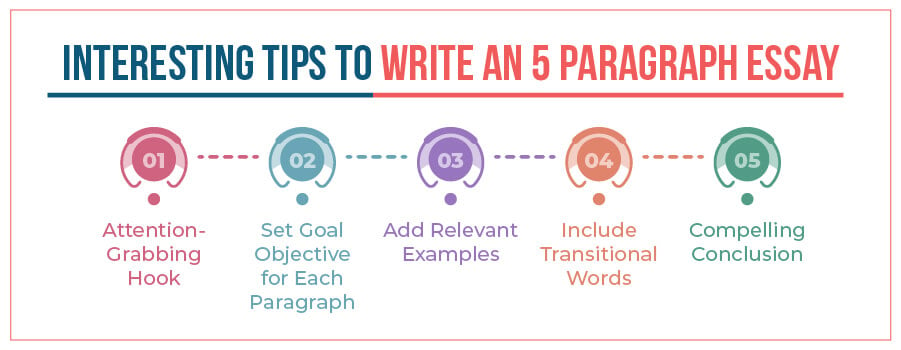
Are you looking for some amazing tips that can help you draft an outstanding essay and score good grades in your academics? Then this is all yours. In this section, you will learn and understand what experts need to say to write a good document. So, let's quickly get your hands on these tips.
1. Attention-Grabbing Hook: It is crucial to start your essay with a catchy line because the professor will decide how your writing is based on the introduction. So, you should write this part at the end because it requires good ideas. Moreover, for this, you can include questions, quotes, and more.
2. Set Goal Objectives for Each Paragraph: You should have a 5 paragraph essay lesson plan for what to write in each paragraph. Do you know why it is important? It is because students always lack the ability the ability to collect enough information to write three body paragraphs. Therefore, while selecting a topic, create a structure that you need to follow.
3. Add Relevant Examples: Adding examples to your 5-paragraph essay will work best. It is because it helps the reader easily connect with and understand your argument, and it also becomes more convenient for you to put forward your point. So, state examples and evidence in support of your arguments.
4. Include Transitional Words: Transitional words are the cues that assist the reader in interpreting your ideas. It avoids the abrupt jumps between the sentences and carries your thoughts from one sentence to another and also from one paragraph to another. It is crucial, as it also enhances the quality of your paper and presents a clear thought.
5. Compelling Conclusion: The ending is also crucial because you never know by reading what paragraph your reader's impressed. Moreover, if you need a 5 paragraph essay example or a sample of how to write the end part, consult our experts for help.
These are the few tips that you need to note down to write an outstanding 5 paragraph essay. But what is the point of these tips if you do not have a good topic? So, let's solve this issue too. In this next part, you will go through the list of trending ideas that will work best for you.
Most of the students often search for a good topic for a 5-paragraph essay but can't find one. Therefore, if you also get confused when choosing an idea, do not worry! This part is curated with handpicked titles by our experts that can help you select one for your paper. So, let's begin reading it.
1. Explain in what ways peer pressure impacts individuals.
2. What is necessary to have in a friendship? Why?
3. Do professors put too much pressure on scholars to participate in extracurricular activities?
4. Is fast food to blame for the obesity concern?
5. Explain how music influences student performance during homework, tests, or writing.
6. For or against, should students be allowed to listen to music during tests?
7. Should students be mandated to carry their own computers or tablets to colleges?
8. Do movie ratings impact people's opinions about seeing a movie?
9. What should the curfew be in the state or at your residence? Why?
10. Describe the ways you prevent bullying at your universities. What can you do to raise awareness?
11. Should standardized examinations be mandated in colleges? Why or why not?
12. What are some options for standardised testing in colleges? Will they work as well?
13. How can we control animal extinction and risk? What can we do as a country or a state? What can individuals do?
14. Should e-books or physical textbooks be used in academies for better results for students?
15. Should students have more freedom at the academy? In what areas?
These were the five-paragraph essay topics, and we hope you have chosen one that matches your interest area. Now, after choosing the title, students also face challenges while writing it. Therefore, if you are also in such a situation, seek assignment help from our experts. Also, to learn how to take assistance, read the next part.
Do You Want to Enhance Your 5 Paragraph Essay?
Reach out to Our Experts for Best Assistance
Well, this was all about the 5 paragraph essay writing that you should know to draft an excellent paper and score A+ academic grades. Also, you must have loved the hamburger example in the format part. However, if you are too close to your deadline and it seems like you cannot write your document before the time period, you can get our academic writing services . Our experts are ready to solve all your problems by providing quick solutions.
Moreover, they also focus on 100% plagiarism-free documents of top quality. So, if you are looking for someone you should trust for the best result, The answer to this is in front of you: consult with our professionals at any time. Therefore, go now and grab this opportunity!
Share Your Requirements Now for Customized Solutions.
Delivered on-time or your money back
Our Services
- Assignment Writing Service
- Essay Writing Help
- Dissertation Writing Service
- Coursework Writing Service
- Proofreading & Editing Service
- Online Exam Help
- Term paper writing service
- Ghost Writing Service
- Case Study Writing Service
- Research Paper Writing Service
- Personal Statement Writing Service
- Resume Writing Service
- Report Writing Service
To Make Your Work Original
Check your work against paraphrasing & get a free Plagiarism report!
Check your work against plagiarism & get a free Plagiarism report!
Quick and Simple Tool to Generate Dissertation Outline Instantly
Get citations & references in your document in the desired style!
Make your content free of errors in just a few clicks for free!
Generate plagiarism-free essays as per your topic’s requirement!
Generate a Compelling Thesis Statement and Impress Your Professor
FREE Features
- Topic Creation USD 3.87 FREE
- Outline USD 9.33 FREE
- Unlimited Revisions USD 20.67 FREE
- Editing/Proofreading USD 28 FREE
- Formatting USD 8 FREE
- Bibliography USD 7.33 FREE
Get all these features for
USD 80.67 FREE
RELATED BLOGS
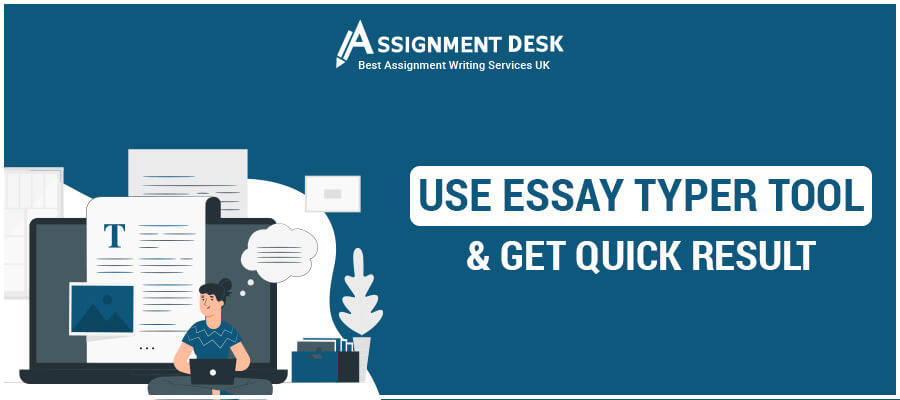
Use our Essay Typer Tool to Write an Amazing Essay Paragraph 2024
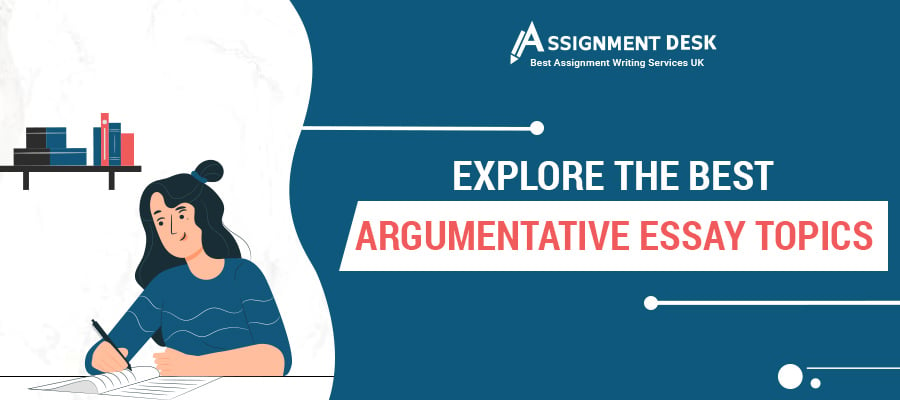
50+ Interesting Argumentative Essay Topics | Assignment Desk

How to Write Reflective Essay? A Complete Guide to Follow
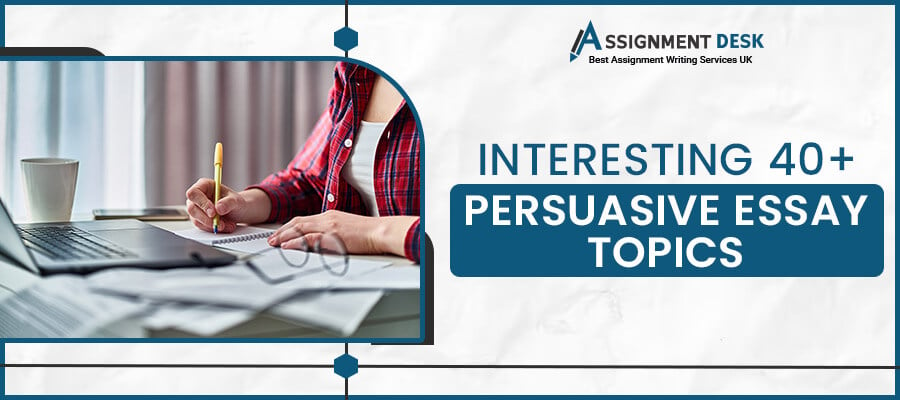
Here Are the Top 40+ Engaging Persuasive Essay Topics
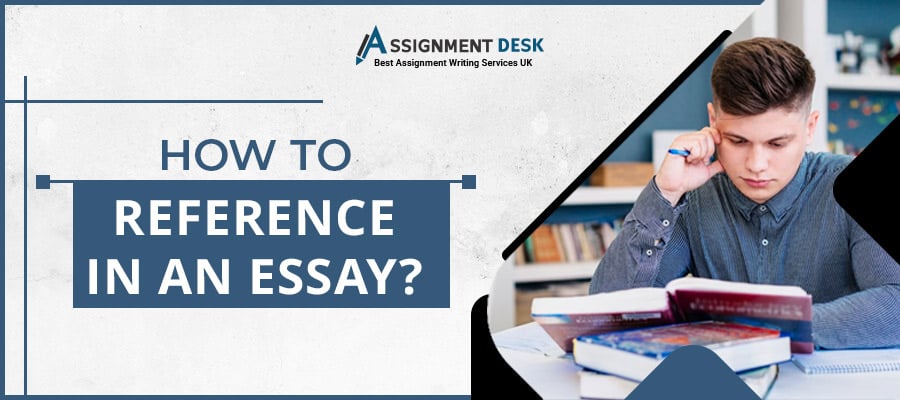
How to Reference in an Essay? Quick and Easy Guide!
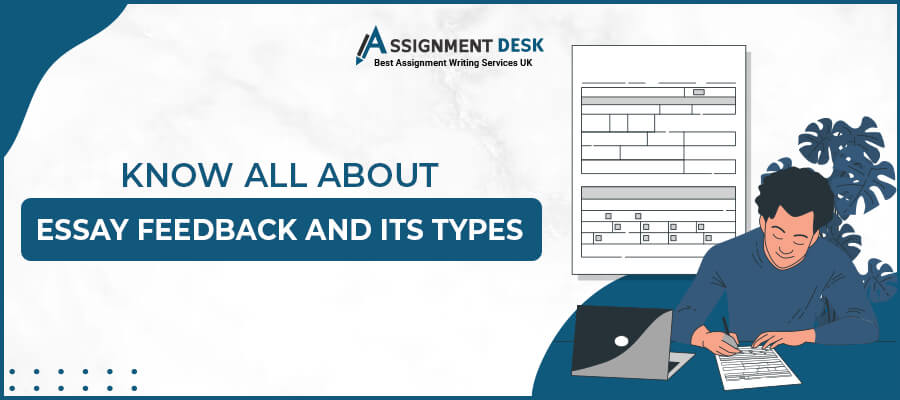
Essay Feedback: Importance and How to Implement It
Professional assignment writers.
Choose a writer for your task among hundreds of professionals

Please rotate your device
We don't support landscape mode yet. Please go back to portrait mode for the best experience
We use cookies to ensure that we give you the best experience on our website. If you continue to use this site we will assume that you are happy with it. Know more
Calculate the Price
Professional Academic Help at Pocket-Friendly Prices!
Estimated Price
Limited Time Offer
Exclusive Library Membership + FREE Wallet Balance
1 Month Access !
5000 Student Samples
10,000 Answers by Experts
Get $300 Now

Microsoft 365 Life Hacks > Writing > The pros and cons of the five-paragraph essay
The pros and cons of the five-paragraph essay
The five-paragraph essay is a writing structure typically taught in high school. Structurally, it consists of an introductory paragraph, three body paragraphs, and a conclusion. This clear structure helps students connect points into a succinct argument. It’s a great introductory structure, but only using this writing formula has its limitations.

What is a five-paragraph essay?
Outside of the self-titled structure, the five-paragraph essay has additional rules. To start, your introductory paragraph should include a hook to captivate your audience. It should also introduce your thesis , or the argument you are proving. The thesis should be one sentence, conclude your introductory paragraph, and include supporting points. These points will become the body of your essay. The body paragraphs should introduce a specific point, include examples and supporting information, and then conclude. This process is repeated until you reach the fifth concluding paragraph, in which you summarize your essay.

Get the most out of your documents with Word
Elevate your writing and collaborate with others - anywhere, anytime
The benefits of a five-paragraph essay
- Your ideas are clear. Presenting your ideas in a succinct, organized manner makes them easy to understand and the five-paragraph essay is designed for that. It provides a clear outline to follow. And most importantly, it’s organized around the thesis, so the argument can be traced from the beginning of the essay to its conclusion. When learning how to write essays, losing track of your thesis can be a common mistake. By using this structure, it’s harder to go on tangents. Each of your points are condensed into a single paragraph. If you struggle presenting your ideas, following this structure might be your best bet.
- It’s simple. Creating an essay structure takes additional brainpower and time to craft. If an essay is timed in an exam, relying on this method is helpful. You can quickly convey your ideas so you can spend more time writing and less structuring your essay.
- It helps build your writing skills. If you’re new to writing essays, this is a great tool. Since the structure is taken care of, you can practice writing and build your skills. Learn more writing tips to improve your essays.
The cons of writing a five-paragraph essay
- The structure is rigid. Depending on its usage, the structure and convention of the five paragraphs can make creating an essay easier to understand and write. However, for writing outside of a traditional high school essay, this format can be limiting. To illustrate points creatively, you might want to create a different structure to illustrate your argument.
- Writing becomes repetitive. This format quickly becomes repetitive. Moving from body-to-body paragraph using the same rules and format creates a predictable rhythm. Reading this predictable format can become dull. And if you’re writing for a college professor, they will want you to showcase creativity in your writing. Try using a different essay structure to make your writing more interesting
- Lack of transitions. Quickly moving through ideas in a five-paragraph structure essay doesn’t always leave room for transitions. The structure is too succinct. Each paragraph only leaves enough space for a writer to broadly delve into an idea and then move onto the next. In longer essays, you can use additional paragraphs to connect ideas. Without transitions, essays in this format can feel choppy, as each point is detached from the previous one
- Its rules can feel unnecessary. Breaking your essay into three body paragraphs keeps it concise. But is three the perfect number of body paragraphs? Some arguments might need more support than three points to substantiate them. Limiting your argument to three points can weaken its credibility and can feel arbitrary for a writer to stick to.
Creating essays using the five-paragraph structure is situational. Use your best judgement to decide when to take advantage of this essay formula. If you’re writing on a computer with Microsoft Word , try using Microsoft Editor to edit your essay.
Get started with Microsoft 365
It’s the Office you know, plus the tools to help you work better together, so you can get more done—anytime, anywhere.
Topics in this article
More articles like this one.

What is independent publishing?
Avoid the hassle of shopping your book around to publishing houses. Publish your book independently and understand the benefits it provides for your as an author.

What are literary tropes?
Engage your audience with literary tropes. Learn about different types of literary tropes, like metaphors and oxymorons, to elevate your writing.

What are genre tropes?
Your favorite genres are filled with unifying tropes that can define them or are meant to be subverted.

What is literary fiction?
Define literary fiction and learn what sets it apart from genre fiction.

Everything you need to achieve more in less time
Get powerful productivity and security apps with Microsoft 365

Explore Other Categories
Have a language expert improve your writing
Run a free plagiarism check in 10 minutes, generate accurate citations for free.
- Knowledge Base
- How to conclude an essay | Interactive example
How to Conclude an Essay | Interactive Example
Published on January 24, 2019 by Shona McCombes . Revised on July 23, 2023.
The conclusion is the final paragraph of your essay . A strong conclusion aims to:
- Tie together the essay’s main points
- Show why your argument matters
- Leave the reader with a strong impression
Your conclusion should give a sense of closure and completion to your argument, but also show what new questions or possibilities it has opened up.
This conclusion is taken from our annotated essay example , which discusses the history of the Braille system. Hover over each part to see why it’s effective.
Braille paved the way for dramatic cultural changes in the way blind people were treated and the opportunities available to them. Louis Braille’s innovation was to reimagine existing reading systems from a blind perspective, and the success of this invention required sighted teachers to adapt to their students’ reality instead of the other way around. In this sense, Braille helped drive broader social changes in the status of blindness. New accessibility tools provide practical advantages to those who need them, but they can also change the perspectives and attitudes of those who do not.
Instantly correct all language mistakes in your text
Upload your document to correct all your mistakes in minutes

Table of contents
Step 1: return to your thesis, step 2: review your main points, step 3: show why it matters, what shouldn’t go in the conclusion, more examples of essay conclusions, other interesting articles, frequently asked questions about writing an essay conclusion.
To begin your conclusion, signal that the essay is coming to an end by returning to your overall argument.
Don’t just repeat your thesis statement —instead, try to rephrase your argument in a way that shows how it has been developed since the introduction.
Receive feedback on language, structure, and formatting
Professional editors proofread and edit your paper by focusing on:
- Academic style
- Vague sentences
- Style consistency
See an example
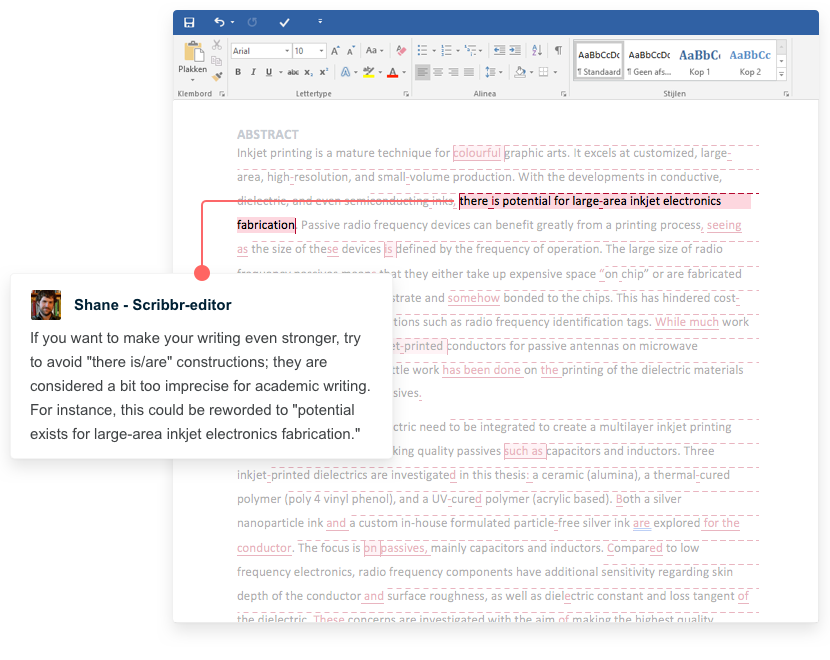
Next, remind the reader of the main points that you used to support your argument.
Avoid simply summarizing each paragraph or repeating each point in order; try to bring your points together in a way that makes the connections between them clear. The conclusion is your final chance to show how all the paragraphs of your essay add up to a coherent whole.
To wrap up your conclusion, zoom out to a broader view of the topic and consider the implications of your argument. For example:
- Does it contribute a new understanding of your topic?
- Does it raise new questions for future study?
- Does it lead to practical suggestions or predictions?
- Can it be applied to different contexts?
- Can it be connected to a broader debate or theme?
Whatever your essay is about, the conclusion should aim to emphasize the significance of your argument, whether that’s within your academic subject or in the wider world.
Try to end with a strong, decisive sentence, leaving the reader with a lingering sense of interest in your topic.
The easiest way to improve your conclusion is to eliminate these common mistakes.
Don’t include new evidence
Any evidence or analysis that is essential to supporting your thesis statement should appear in the main body of the essay.
The conclusion might include minor pieces of new information—for example, a sentence or two discussing broader implications, or a quotation that nicely summarizes your central point. But it shouldn’t introduce any major new sources or ideas that need further explanation to understand.
Don’t use “concluding phrases”
Avoid using obvious stock phrases to tell the reader what you’re doing:
- “In conclusion…”
- “To sum up…”
These phrases aren’t forbidden, but they can make your writing sound weak. By returning to your main argument, it will quickly become clear that you are concluding the essay—you shouldn’t have to spell it out.
Don’t undermine your argument
Avoid using apologetic phrases that sound uncertain or confused:
- “This is just one approach among many.”
- “There are good arguments on both sides of this issue.”
- “There is no clear answer to this problem.”
Even if your essay has explored different points of view, your own position should be clear. There may be many possible approaches to the topic, but you want to leave the reader convinced that yours is the best one!
Prevent plagiarism. Run a free check.
- Argumentative
- Literary analysis
This conclusion is taken from an argumentative essay about the internet’s impact on education. It acknowledges the opposing arguments while taking a clear, decisive position.
The internet has had a major positive impact on the world of education; occasional pitfalls aside, its value is evident in numerous applications. The future of teaching lies in the possibilities the internet opens up for communication, research, and interactivity. As the popularity of distance learning shows, students value the flexibility and accessibility offered by digital education, and educators should fully embrace these advantages. The internet’s dangers, real and imaginary, have been documented exhaustively by skeptics, but the internet is here to stay; it is time to focus seriously on its potential for good.
This conclusion is taken from a short expository essay that explains the invention of the printing press and its effects on European society. It focuses on giving a clear, concise overview of what was covered in the essay.
The invention of the printing press was important not only in terms of its immediate cultural and economic effects, but also in terms of its major impact on politics and religion across Europe. In the century following the invention of the printing press, the relatively stationary intellectual atmosphere of the Middle Ages gave way to the social upheavals of the Reformation and the Renaissance. A single technological innovation had contributed to the total reshaping of the continent.
This conclusion is taken from a literary analysis essay about Mary Shelley’s Frankenstein . It summarizes what the essay’s analysis achieved and emphasizes its originality.
By tracing the depiction of Frankenstein through the novel’s three volumes, I have demonstrated how the narrative structure shifts our perception of the character. While the Frankenstein of the first volume is depicted as having innocent intentions, the second and third volumes—first in the creature’s accusatory voice, and then in his own voice—increasingly undermine him, causing him to appear alternately ridiculous and vindictive. Far from the one-dimensional villain he is often taken to be, the character of Frankenstein is compelling because of the dynamic narrative frame in which he is placed. In this frame, Frankenstein’s narrative self-presentation responds to the images of him we see from others’ perspectives. This conclusion sheds new light on the novel, foregrounding Shelley’s unique layering of narrative perspectives and its importance for the depiction of character.
If you want to know more about AI tools , college essays , or fallacies make sure to check out some of our other articles with explanations and examples or go directly to our tools!
- Ad hominem fallacy
- Post hoc fallacy
- Appeal to authority fallacy
- False cause fallacy
- Sunk cost fallacy
College essays
- Choosing Essay Topic
- Write a College Essay
- Write a Diversity Essay
- College Essay Format & Structure
- Comparing and Contrasting in an Essay
(AI) Tools
- Grammar Checker
- Paraphrasing Tool
- Text Summarizer
- AI Detector
- Plagiarism Checker
- Citation Generator
Your essay’s conclusion should contain:
- A rephrased version of your overall thesis
- A brief review of the key points you made in the main body
- An indication of why your argument matters
The conclusion may also reflect on the broader implications of your argument, showing how your ideas could applied to other contexts or debates.
For a stronger conclusion paragraph, avoid including:
- Important evidence or analysis that wasn’t mentioned in the main body
- Generic concluding phrases (e.g. “In conclusion…”)
- Weak statements that undermine your argument (e.g. “There are good points on both sides of this issue.”)
Your conclusion should leave the reader with a strong, decisive impression of your work.
The conclusion paragraph of an essay is usually shorter than the introduction . As a rule, it shouldn’t take up more than 10–15% of the text.
Cite this Scribbr article
If you want to cite this source, you can copy and paste the citation or click the “Cite this Scribbr article” button to automatically add the citation to our free Citation Generator.
McCombes, S. (2023, July 23). How to Conclude an Essay | Interactive Example. Scribbr. Retrieved April 15, 2024, from https://www.scribbr.com/academic-essay/conclusion/
Is this article helpful?
Shona McCombes
Other students also liked, how to write an essay introduction | 4 steps & examples, how to write a thesis statement | 4 steps & examples, example of a great essay | explanations, tips & tricks, "i thought ai proofreading was useless but..".
I've been using Scribbr for years now and I know it's a service that won't disappoint. It does a good job spotting mistakes”

IMAGES
VIDEO
COMMENTS
When writing a five paragraph essay, it is important to understand the basic structure that makes up this type of essay. The five paragraph essay consists of an introduction, three body paragraphs, and a conclusion. Introduction: The introduction is the first paragraph of the essay and sets the tone for the rest of the piece. It should include ...
The five-paragraph essay format is a guide that helps writers structure an essay. It consists of one introductory paragraph, three body paragraphs for support, and one concluding paragraph. Because of this structure, it has been nicknamed the "hamburger essay," the "one-three-one essay," and the "three-tier essay.".
Write the Introduction. Start the essay with a " hook "—an attention-grabbing statement that will get the reader's interest. This could be an interesting fact, a quote, or a question. After the hook, introduce your topic and end the introduction with a clear thesis statement that presents your main argument or point.
Students can use the following steps to write a standard essay on any given topic. First, choose a topic, or ask your students to choose their topic, then allow them to form a basic five-paragraph by following these steps: Decide on your basic thesis, your idea of a topic to discuss. Decide on three pieces of supporting evidence you will use to ...
Here are some tips from our admission essay writing service to help you write a successful five paragraph essay example: Start with a strong thesis statement: Among the 5 parts of essay, the thesis statement can be the most important. It presents the major topic you will debate throughout your essay while being explicit and simple.
Luckily, five-paragraph essays are really easy to write if you know the expected format and give yourself the time you need to write it. To write your five paragraph essay, draft your introduction, develop three body paragraphs, write your conclusion, and revise and edit your essay. Part 1.
Step 4: Create your essay outline. This step is so important to writing essays that I continue to use outlines to this day for articles and blog posts, which are usually a lot more complicated than five-paragraph essays. But for your five-paragraph essay, here's a good outline to complete: Introductory paragraph.
Write the hook and thesis statement in the first paragraph. Write the conflict of the essay in the second paragraph. Write the supporting details of the conflict in the third paragraph. Write the weakest arguments in the fourth paragraph. Write the summary and call-to-action prompt in the fifth paragraph.
The hamburger essay structure consists of five paragraphs or layers as follows: Layer 1 - The Top Bun: The Introduction. The uppermost layer is the introductory paragraph which communicates to the reader the purpose of the essay. Layers 2,3, & 4 - The Meat Patties: The Body Paragraphs.
The five-paragraph essay consists of one introduction paragraph (with the thesis at its end), three body paragraphs (each beginning with one of three main points) and one last paragraph—the conclusion. 1-3-1. Once you have this outline, you have the basic template for most academic writing. Most of all, you have an organized way to approach ...
If writing isn't one of your favorite requirements of academic life, check out these 10 tips and tricks to navigate creating a five paragraph essay smoothly: Begin early. Make an appointment with the teacher to discuss your ideas/progress and get feedback. Take good notes, and cite the sources as you go. Create a sentence outline before the ...
The 5-paragraph essay is a standard way to write most essays. The 5-paragraph essay has an intr... Here are simple formulas to write the 5-basic academic essay. The 5-paragraph essay is a standard ...
The 5 paragraph essay format is a classic example of an essay, and once you know how to create a 5 paragraph essay outline, you can write any essay that's assigned to you. Perfecting the art of essay writing is not only essential for acing your assignments but also for securing financial support as you transition from high school to college ...
A five-paragraph essay format is short and is often restricted to between 250-750 words. When writing such an essay, you can apply different styles and artistic techniques to different topics and contexts. This answers the question of how many words is a 5 paragraph essay. Types of 5-Paragraph Essay
Second, you can simply reword your thesis statement, starting with "in summary.". The first approach is better, but the second works if you are in a rush. Alternatively, you can use a paragraph summarizer to get the idea of how the conclusion for your particular text may look like. Step 7. Edit Your 5-Paragraph Essay.
Five paragraph essay is a unique format in writing, but it also requires an outline. Such blueprint is very useful because it allows the writer to make a relevant plan and keep it the proper way. The amount of sentences is not as important, as the amount of paragraphs. But usually, each section includes 2-5 sentences, where the author should ...
There's no hard-and-fast requirement for college essays. In high school, you were probably taught to write five-paragraph essays. This is a solid essay structure to work with, but in college, you generally have more flexibility with assignment lengths and formats. Now, consider five the minimum—not the standard—number of paragraphs you ...
5¶E (Five Paragraph Essay) Pros. Cons. Helps you stay organized. Easy/familiar. Helps create proficiency. Good format for timed tests since it's structured and formulaic. Aids in student survival because it's familiar and often utilized in prior education. Helps teachers move through papers with efficiency.
Table of contents. Step 1: Hook your reader. Step 2: Give background information. Step 3: Present your thesis statement. Step 4: Map your essay's structure. Step 5: Check and revise. More examples of essay introductions. Other interesting articles. Frequently asked questions about the essay introduction.
We always start with simple paragraphs. Yes, this is basic, but if your students cannot write excellent paragraphs, their five paragraph essays will be train wrecks. Trust me! We spend a while cementing paragraph structure: Topic Sentence. Detail #1. Detail #2. Detail #3. Closing Sentence.
What is a 5 paragraph essay and its format? The five-paragraph essay is a format of essay that includes five paragraphs: an introduction, three body paragraphs, and a conclusion. You must be wondering if you have heard of such an essay. Yes, you are absolutely correct. This structure is also known as the hamburger essay or the one-three-one.
The five-paragraph essay is a writing structure typically taught in high school. Structurally, it consists of an introductory paragraph, three body paragraphs, and a conclusion. This clear structure helps students connect points into a succinct argument. It's a great introductory structure, but only using this writing formula has its limitations.
Step 1: Return to your thesis. To begin your conclusion, signal that the essay is coming to an end by returning to your overall argument. Don't just repeat your thesis statement —instead, try to rephrase your argument in a way that shows how it has been developed since the introduction. Example: Returning to the thesis.
Writing a five-paragraph essay may seem daunting, but it can be a manageable assignment with the right guidance and structure. This type of essay is commonly taught in schools as a fundamental form of writing, helping students to develop their skills in organizing thoughts and presenting arguments cohesively.
Most Common 5 Essay Types. Essays are long-form written content that aim to inform the reader about a specific topic. It is essential to use the appropriate essay type to convey your topic and thesis to readers. ... If you are writing an essay where you can show your research skills and knowledge about a topic, an expository essay is the way to ...
Hey folks! I'm running on my argumentative essay, and I've reached the belief, but I'm a piece caught on a way to wrap it up correctly. Should I just summarize my essential points, or is there greater to it than that? I need to have a robust impact on my reader and drive home the significance of my argument.